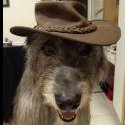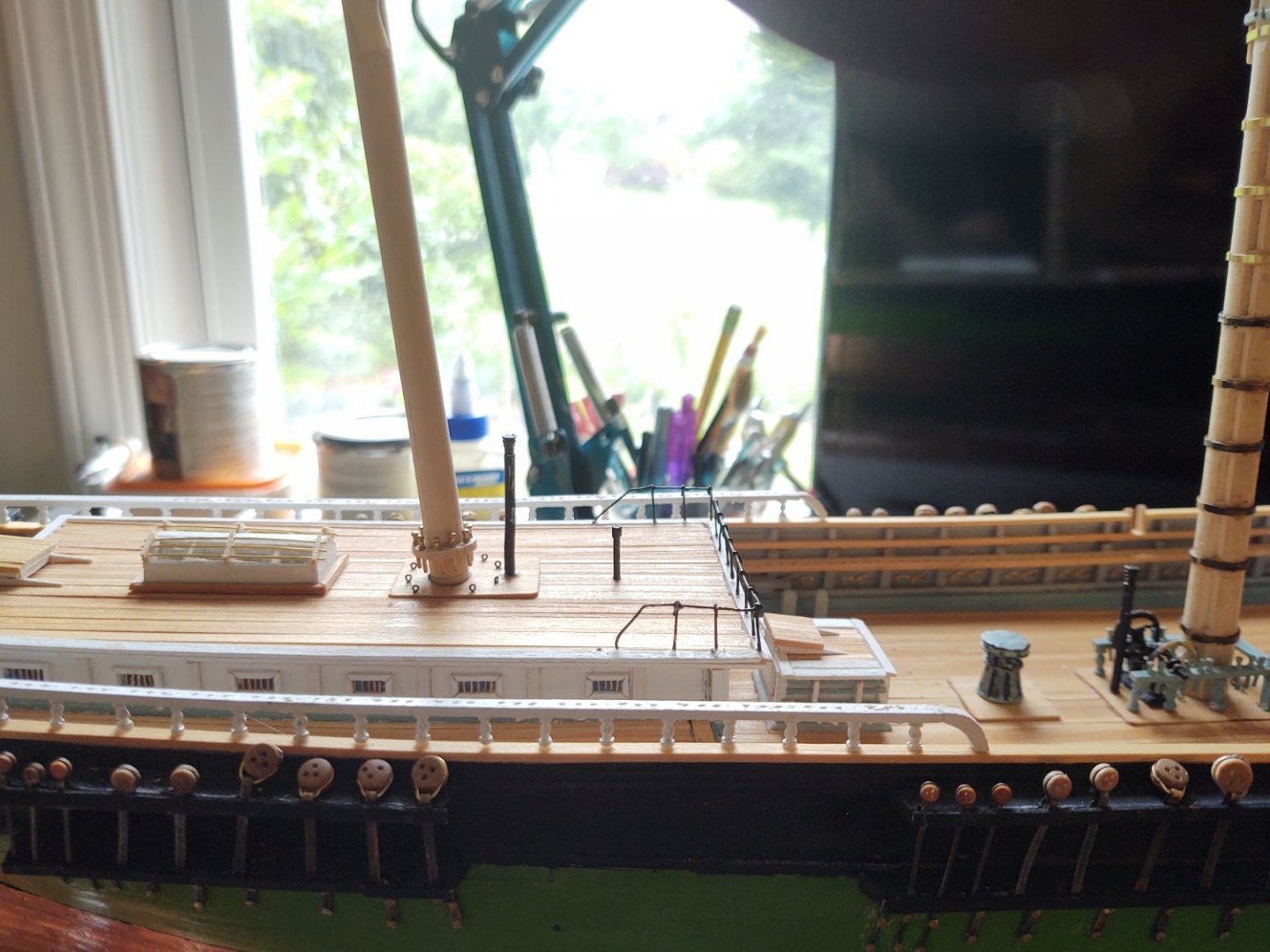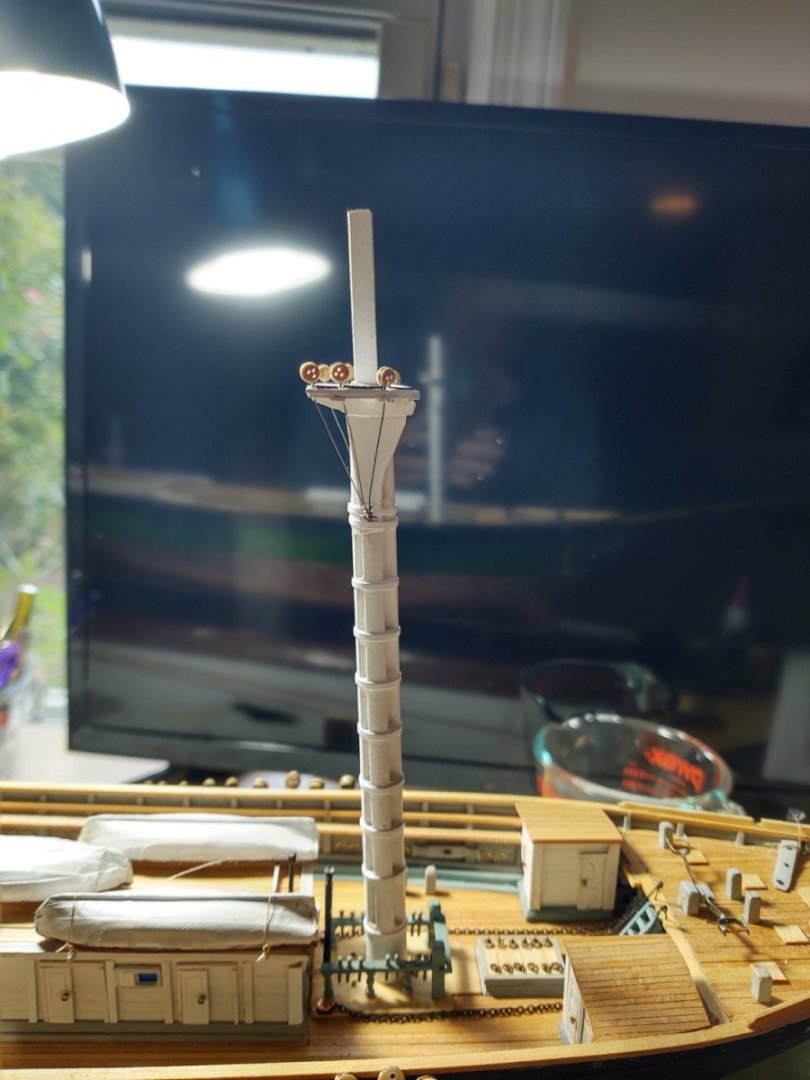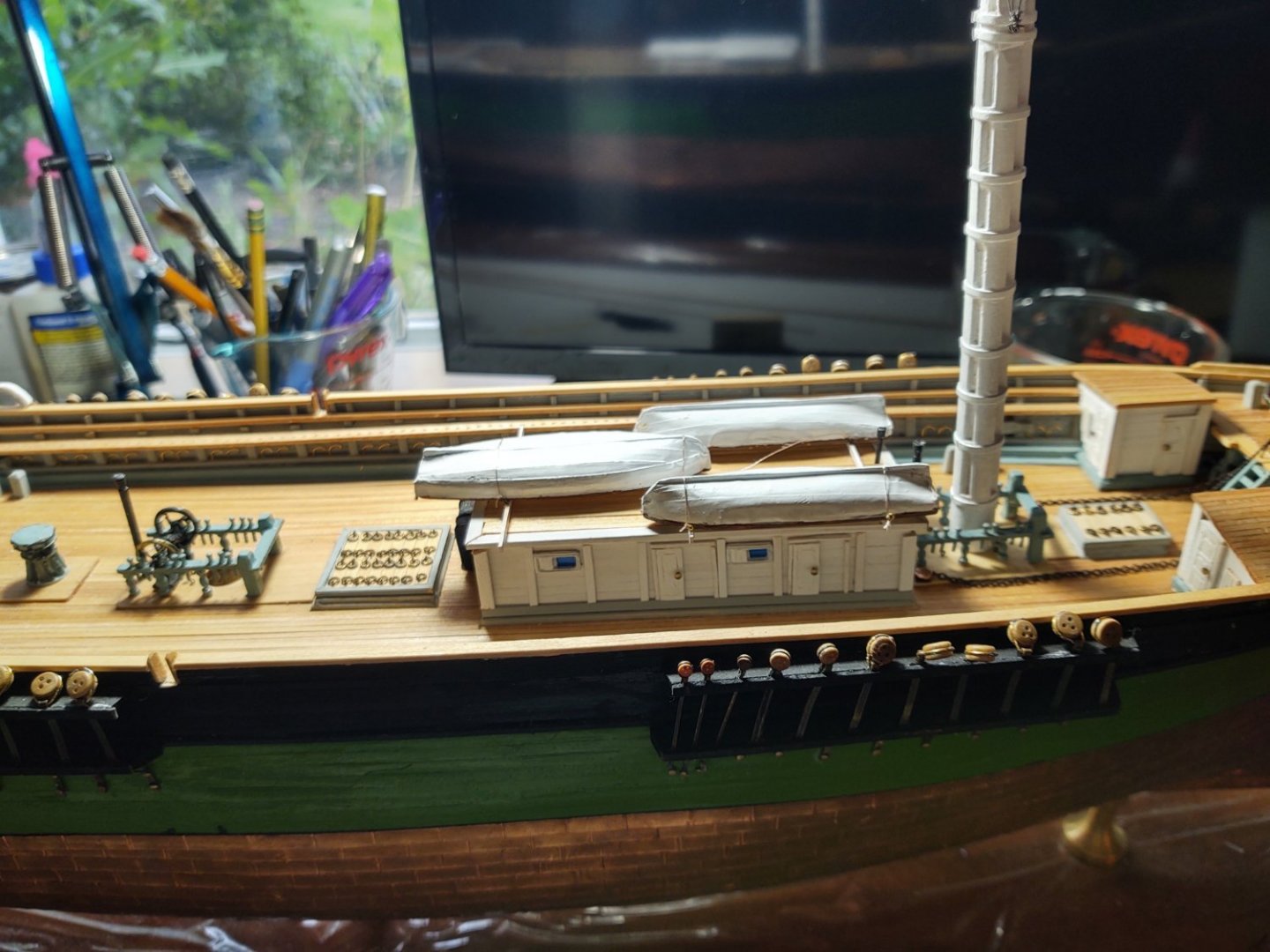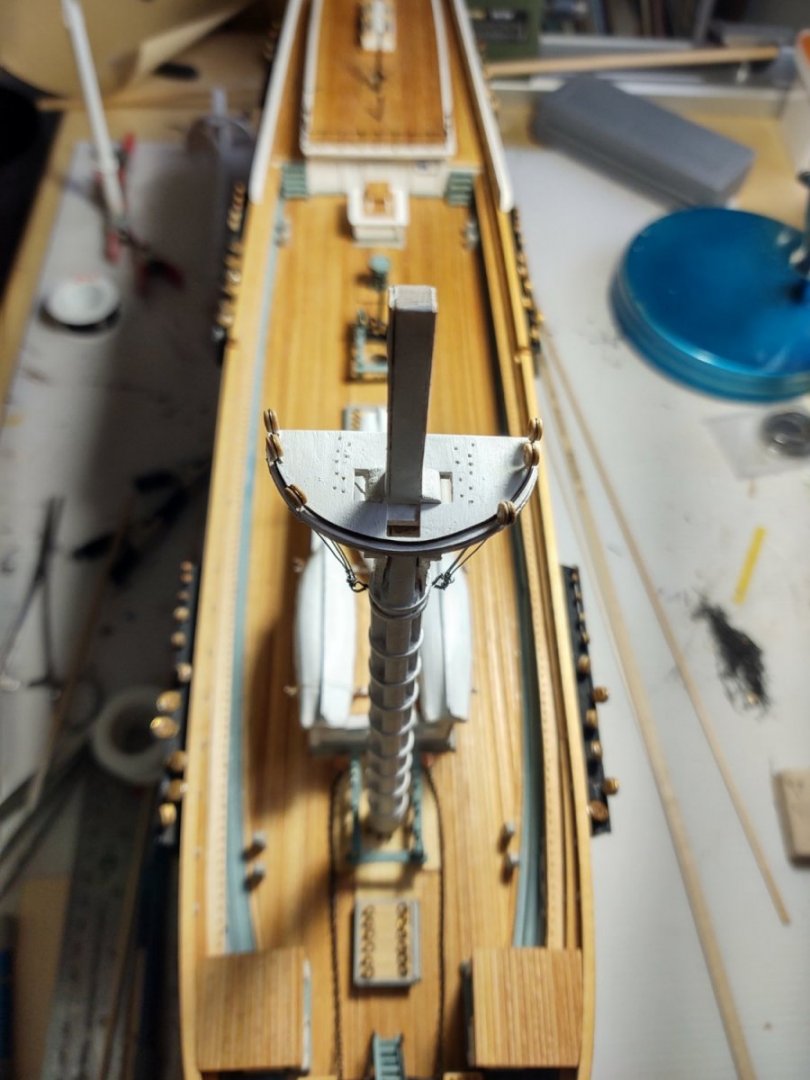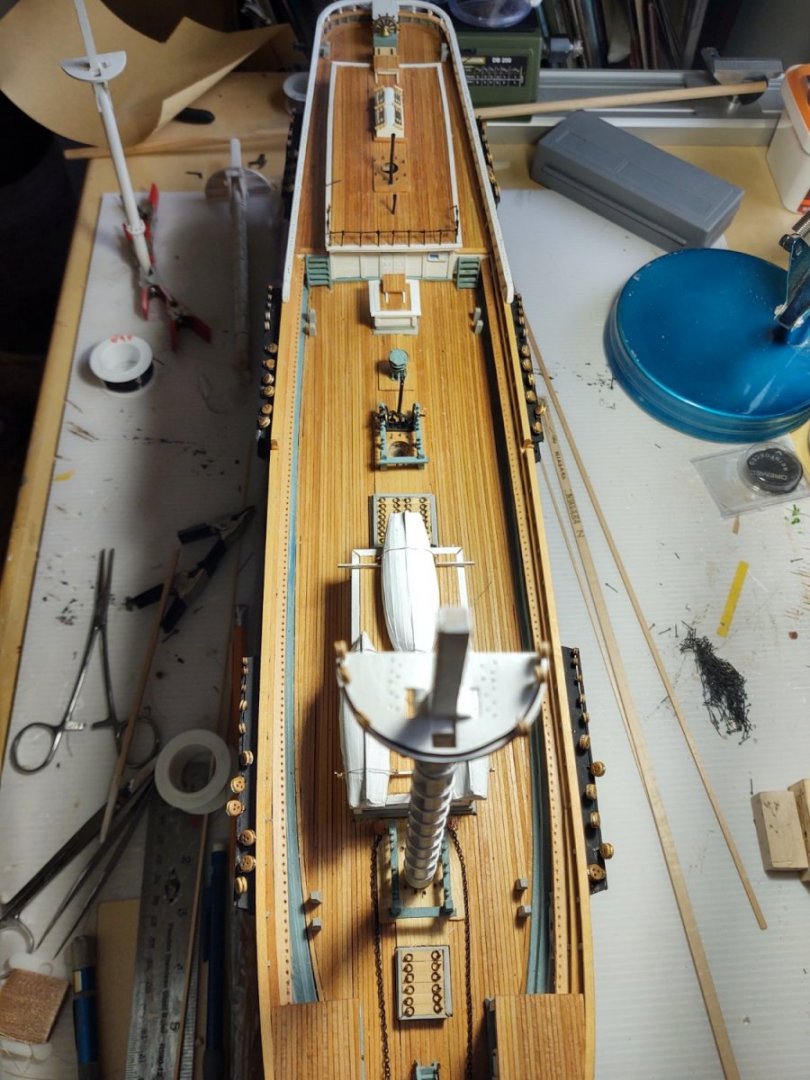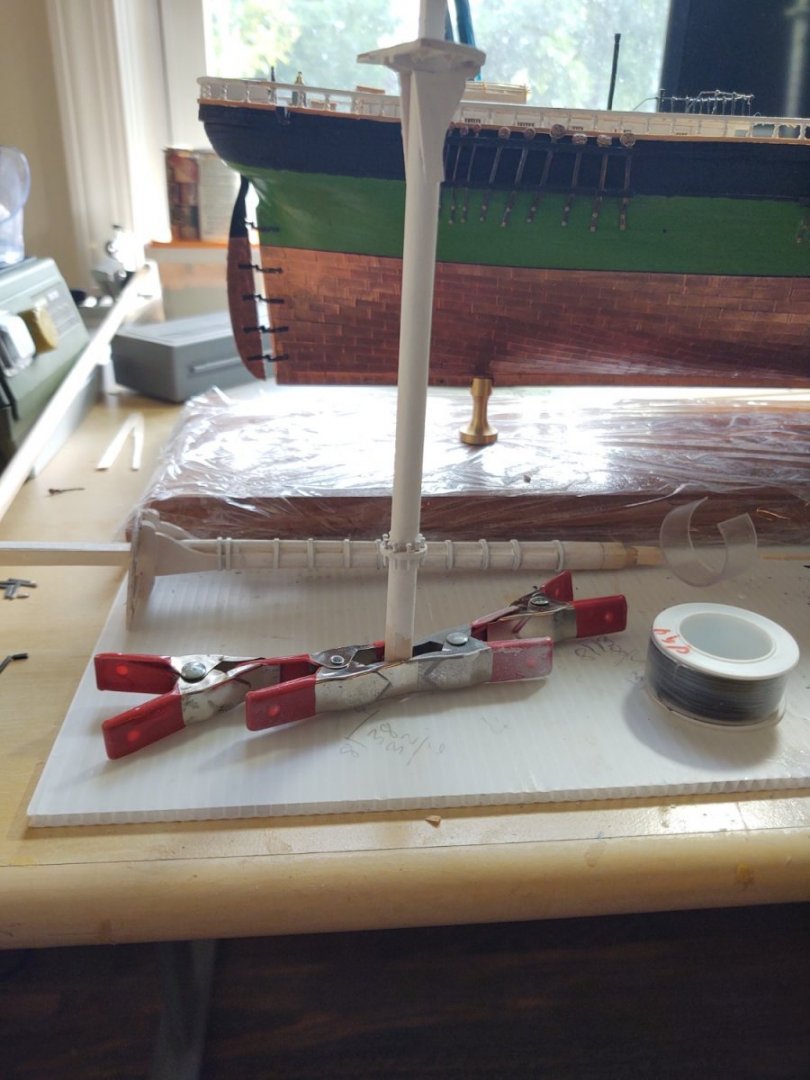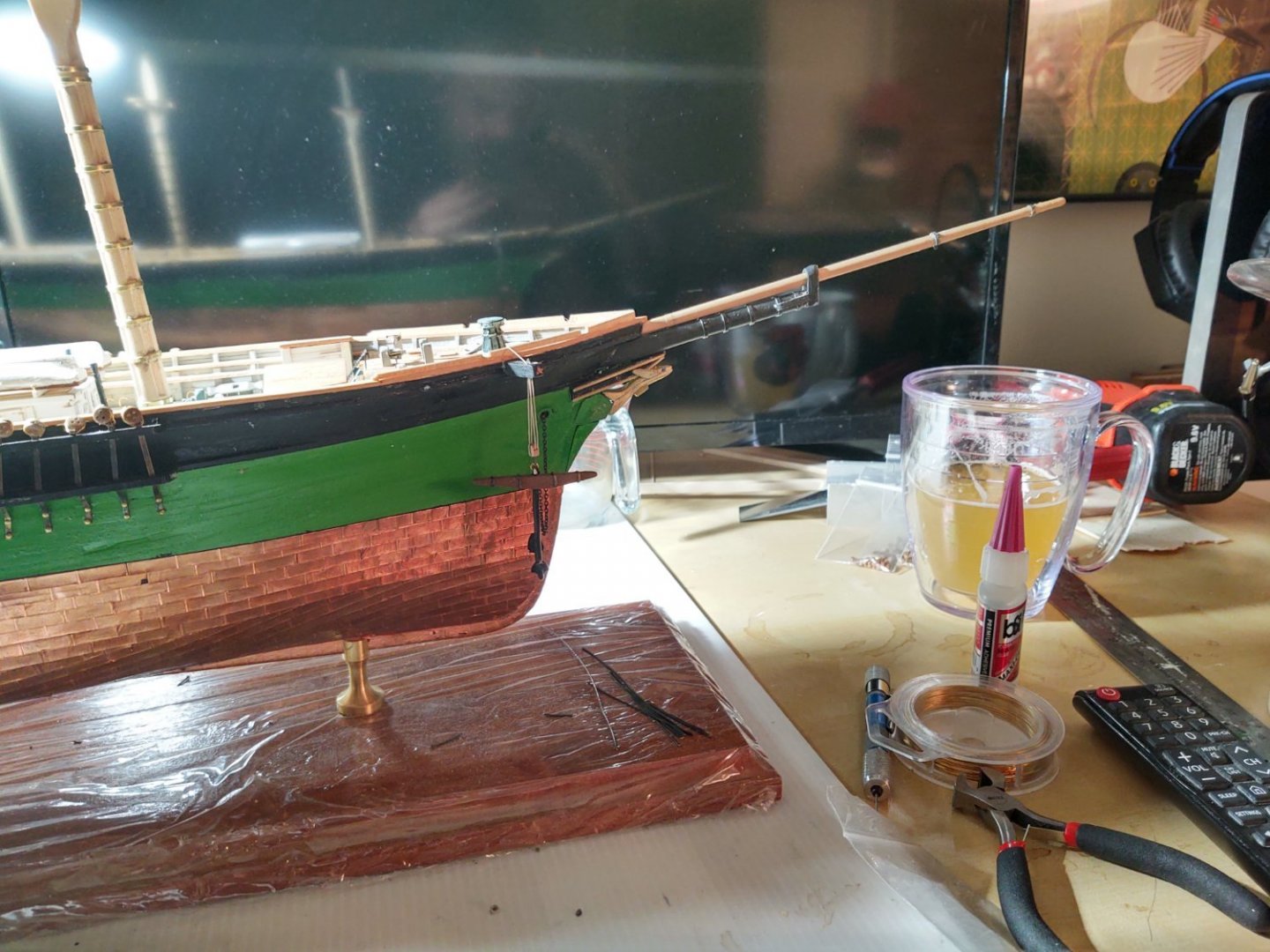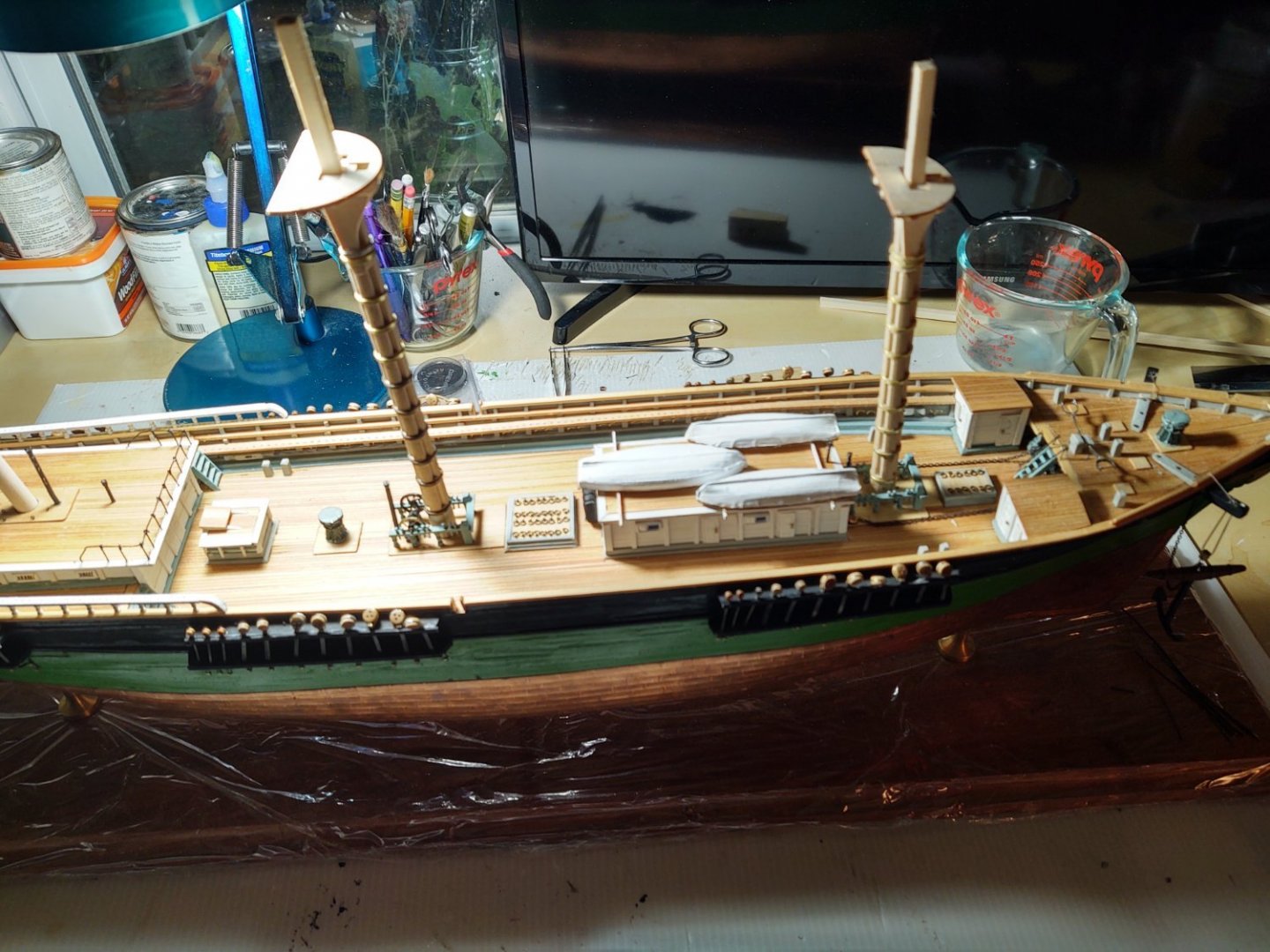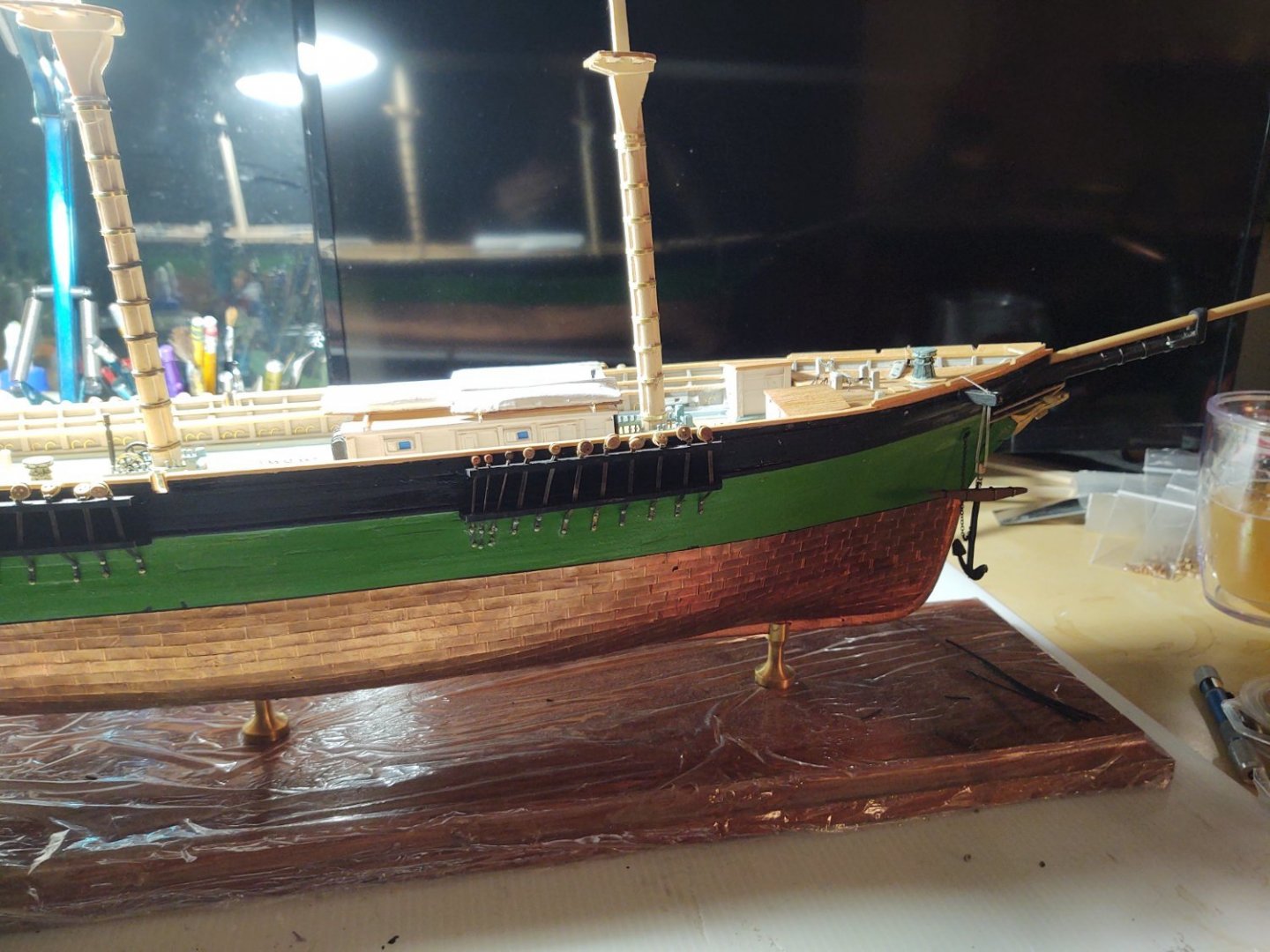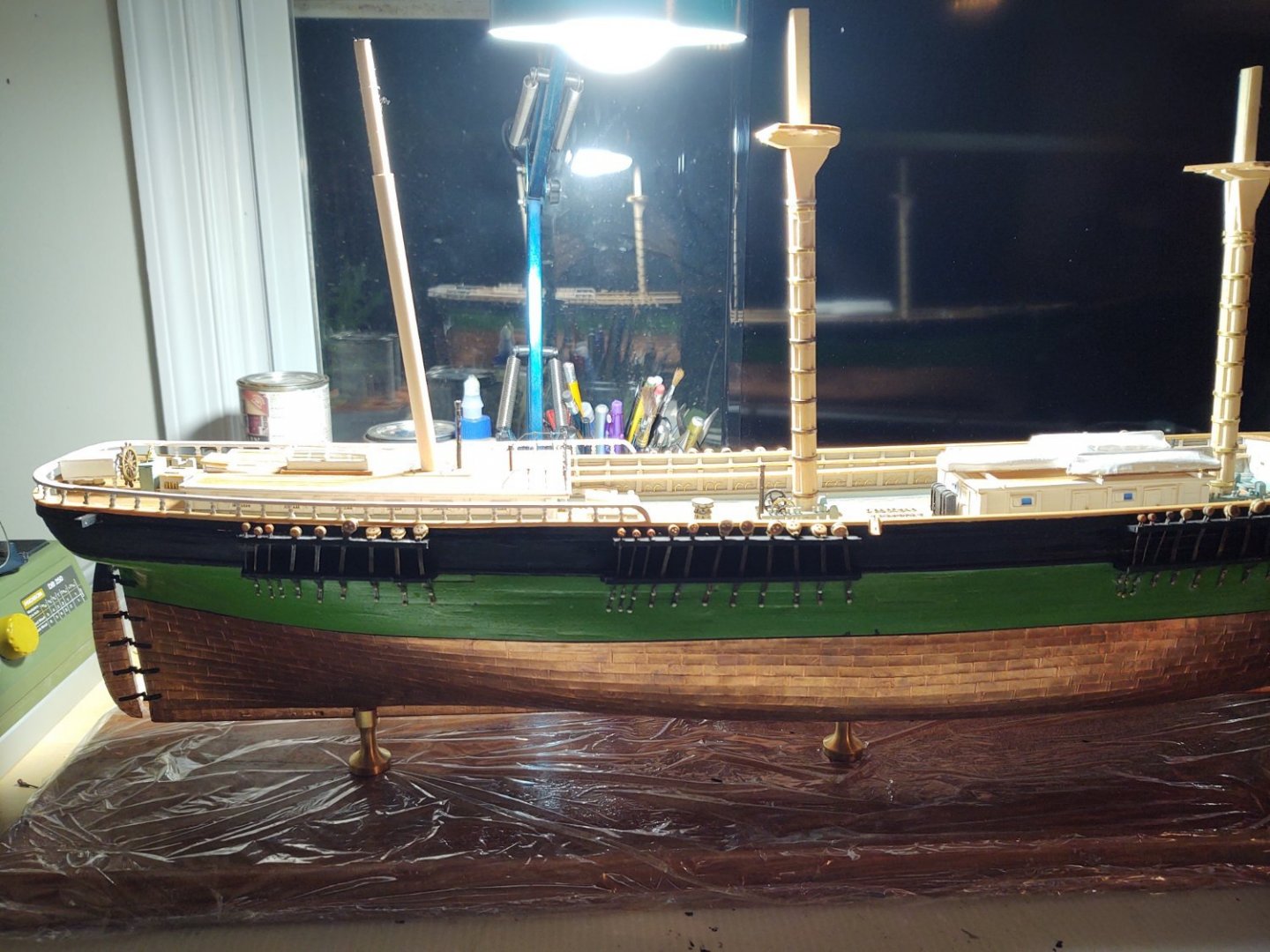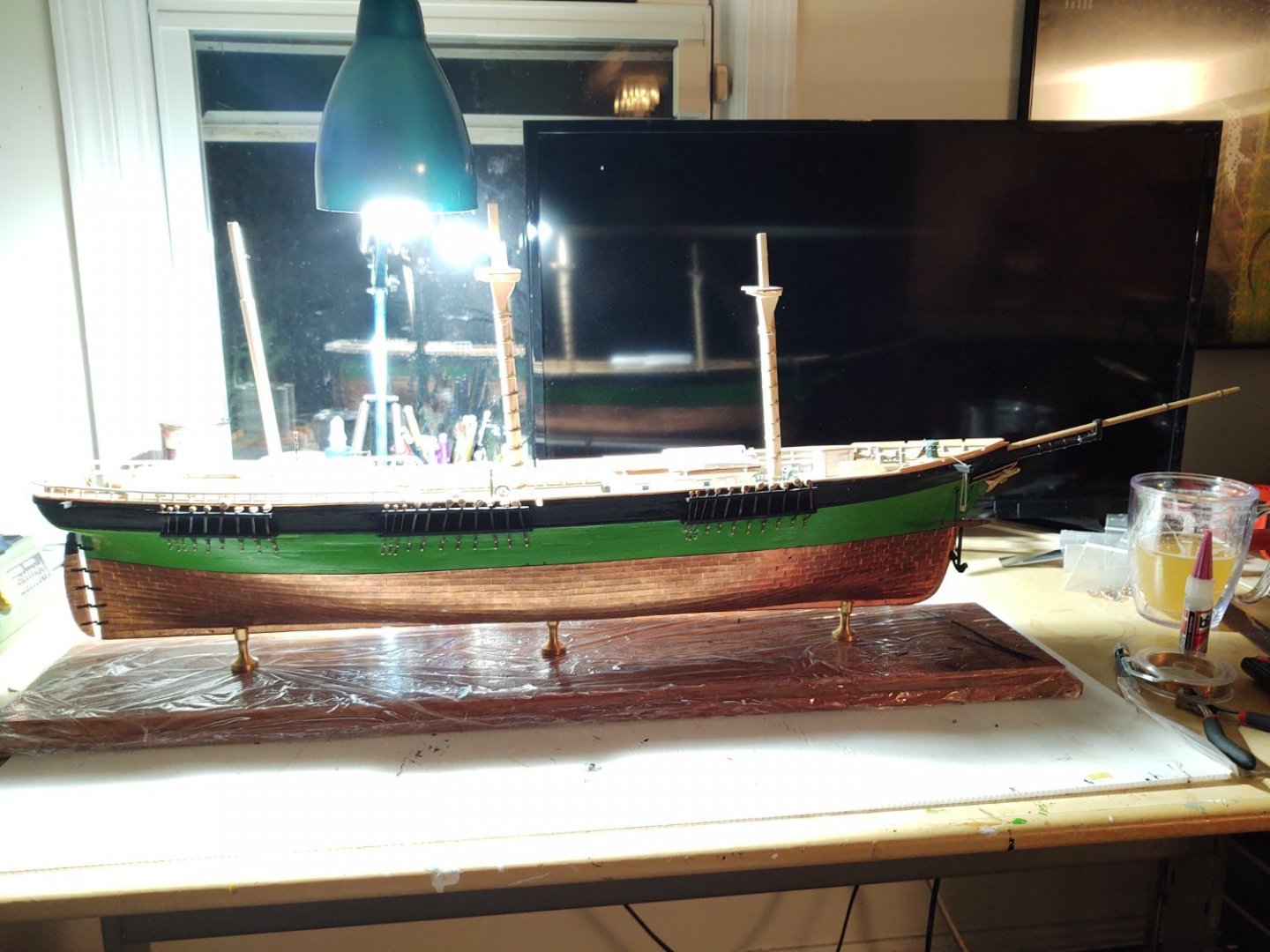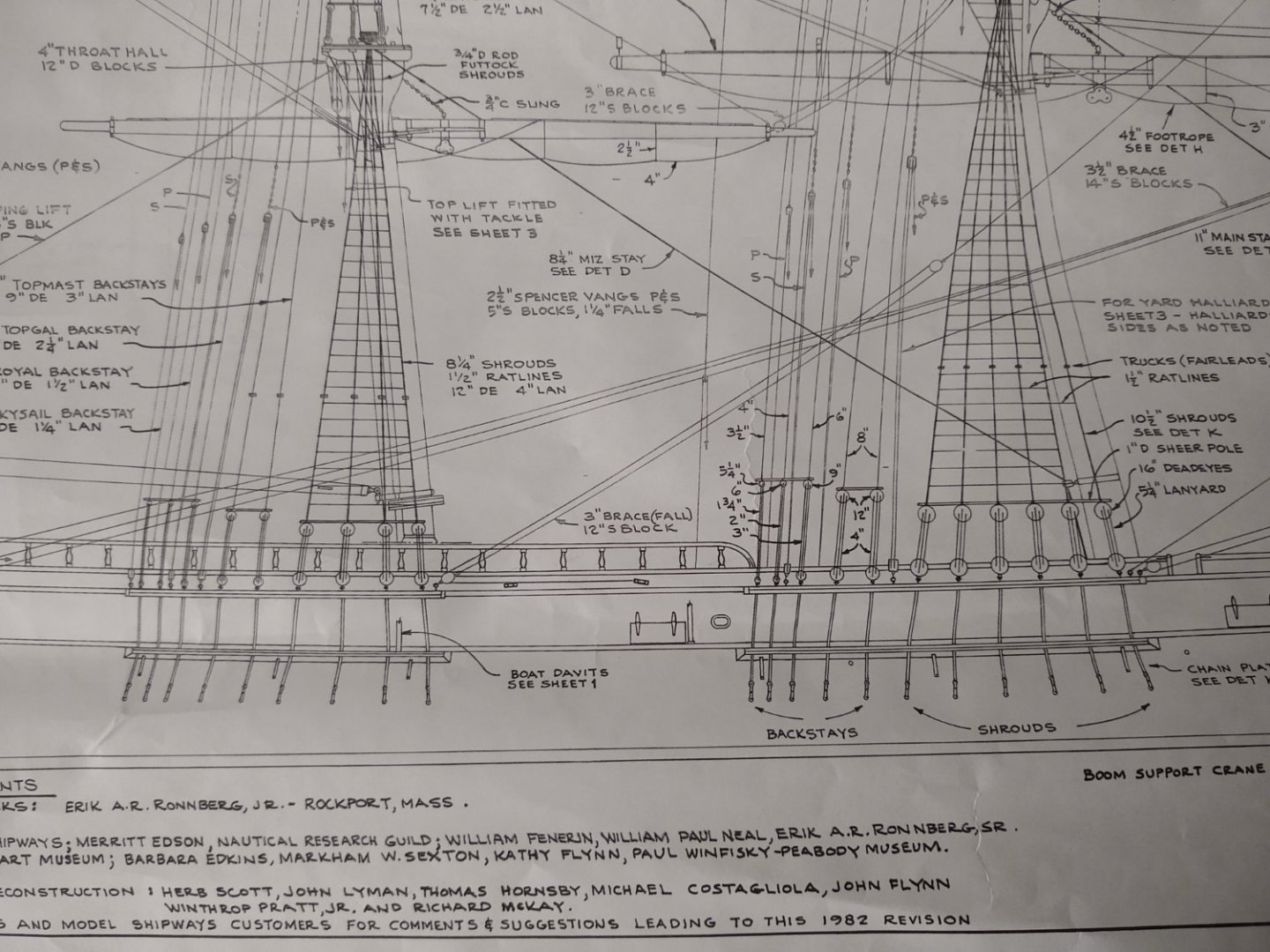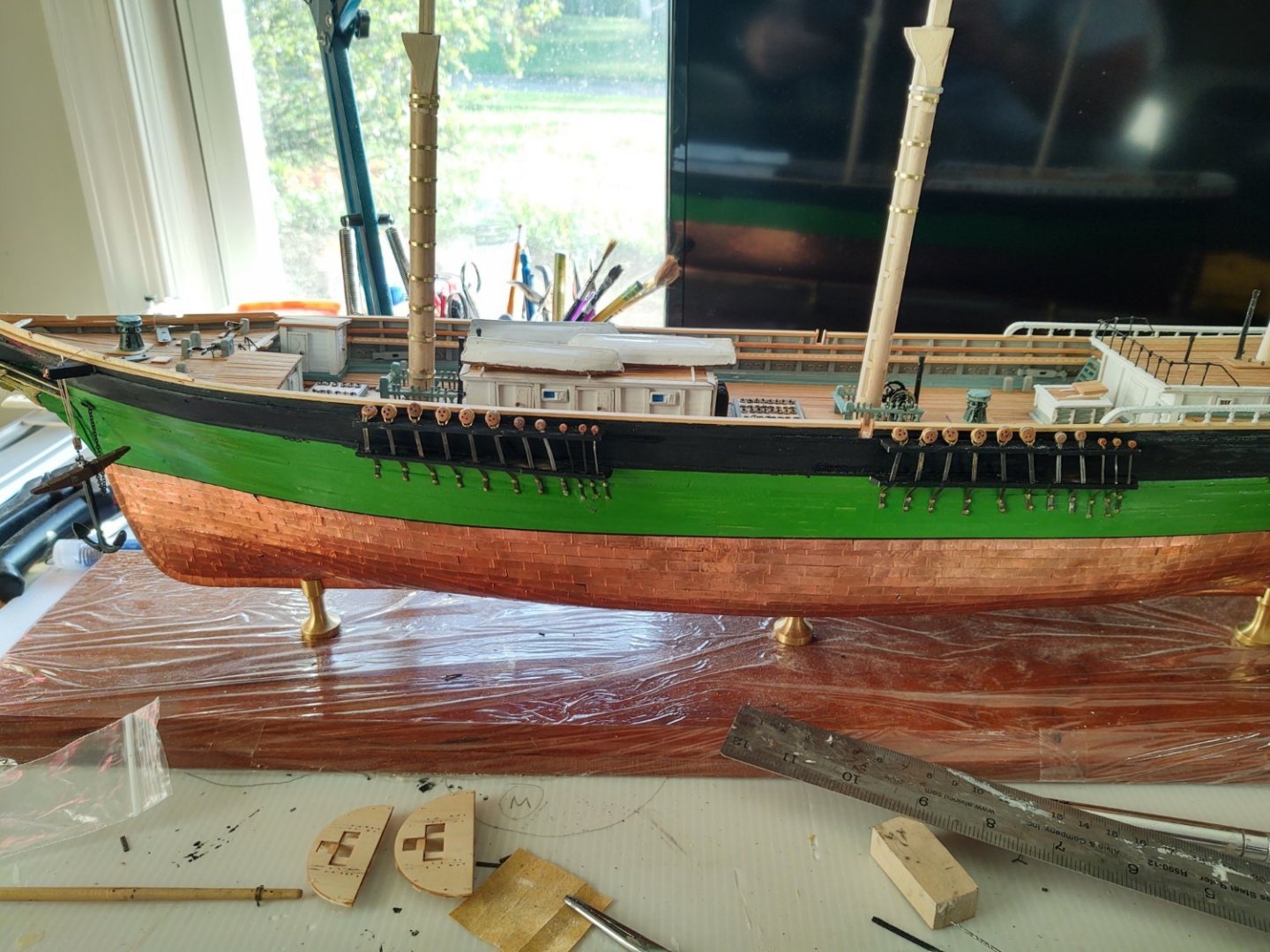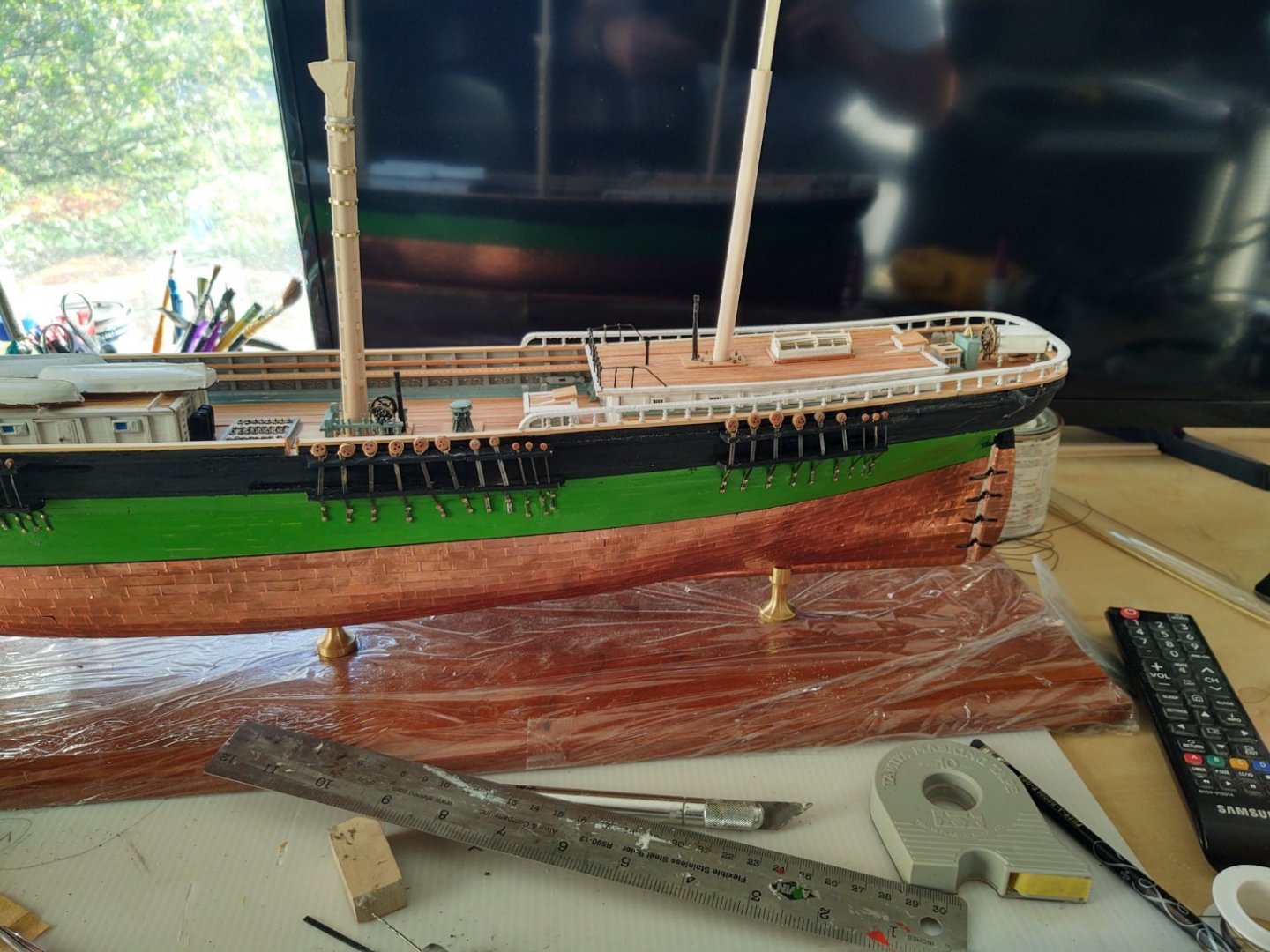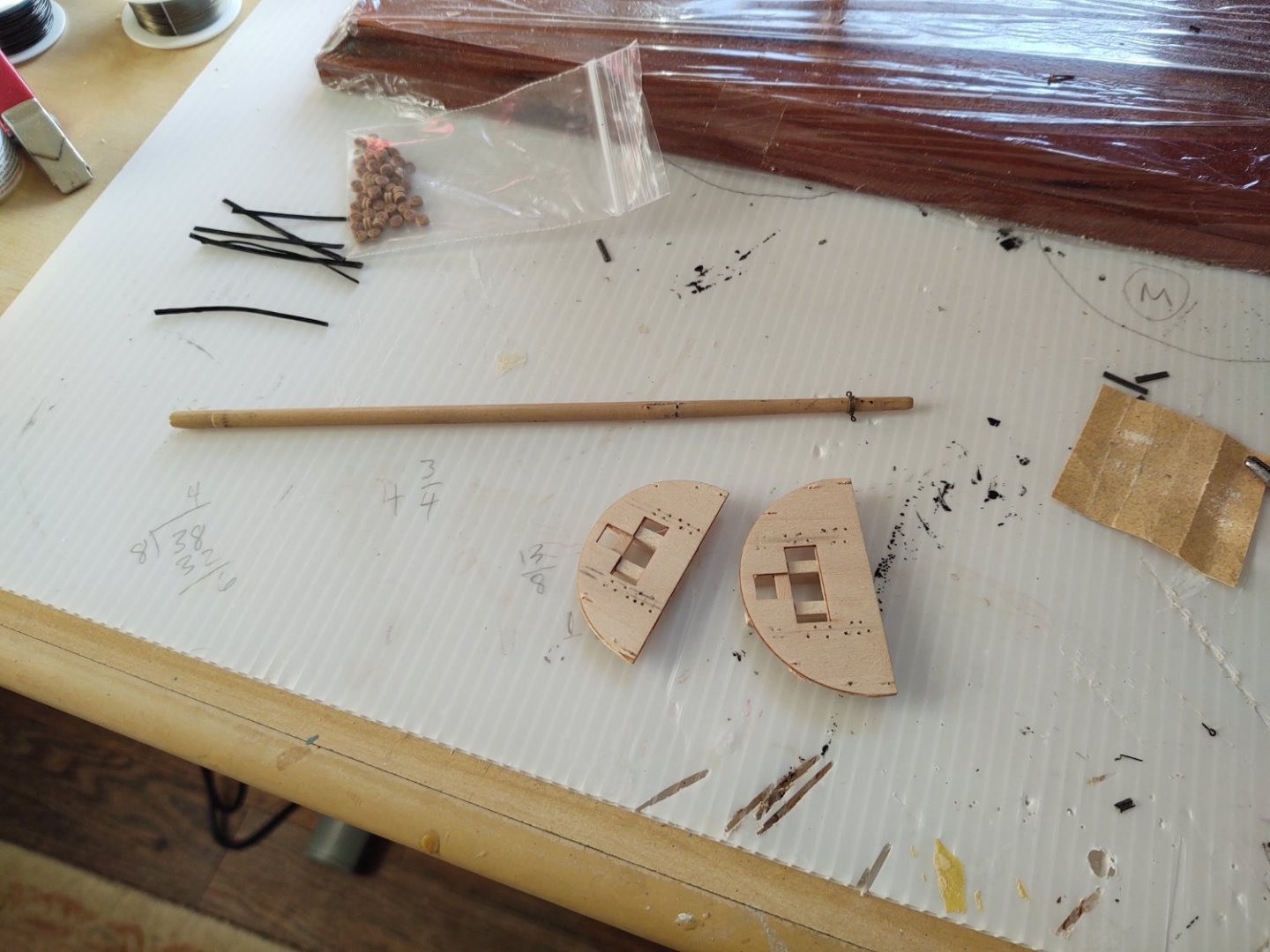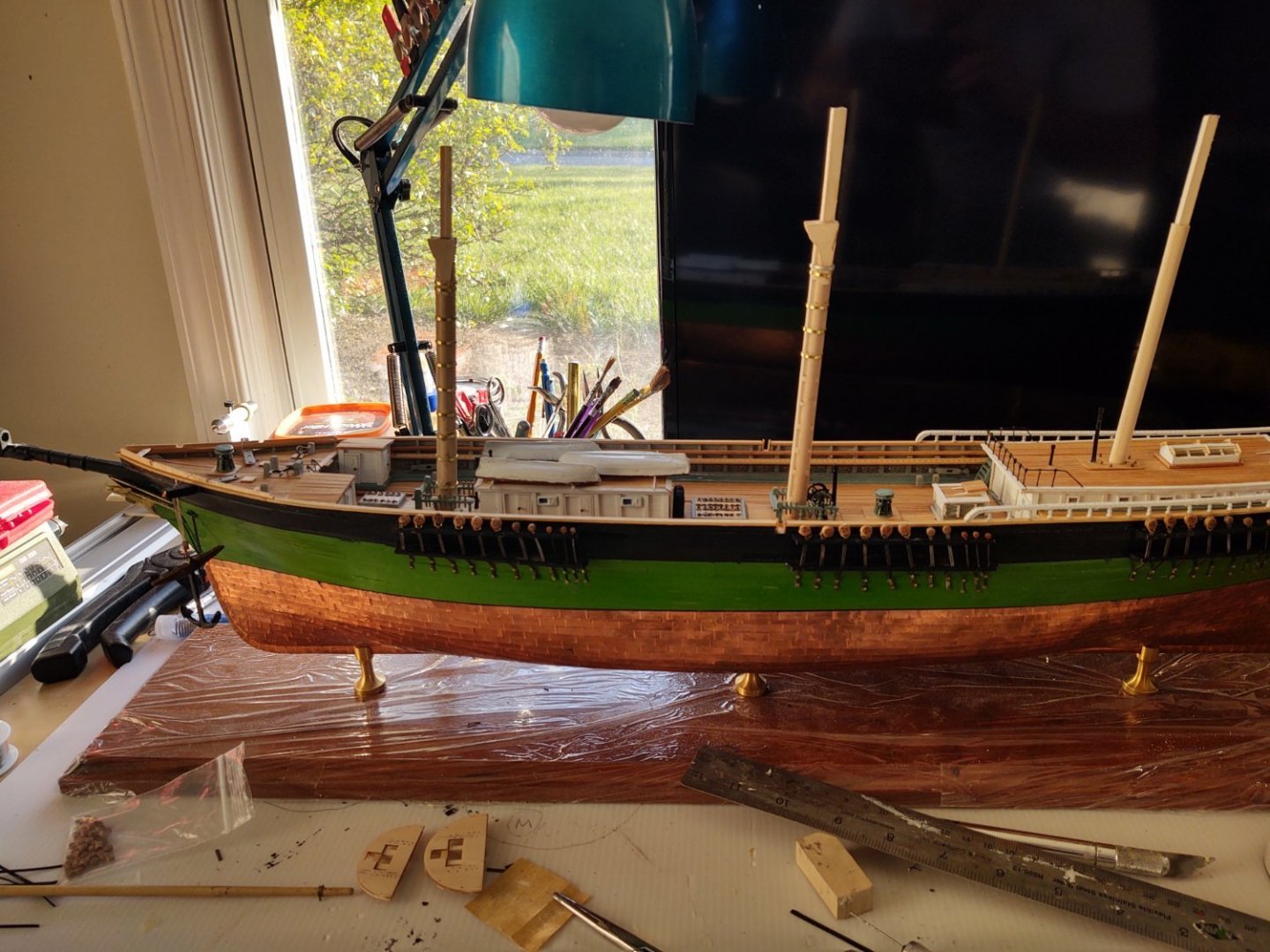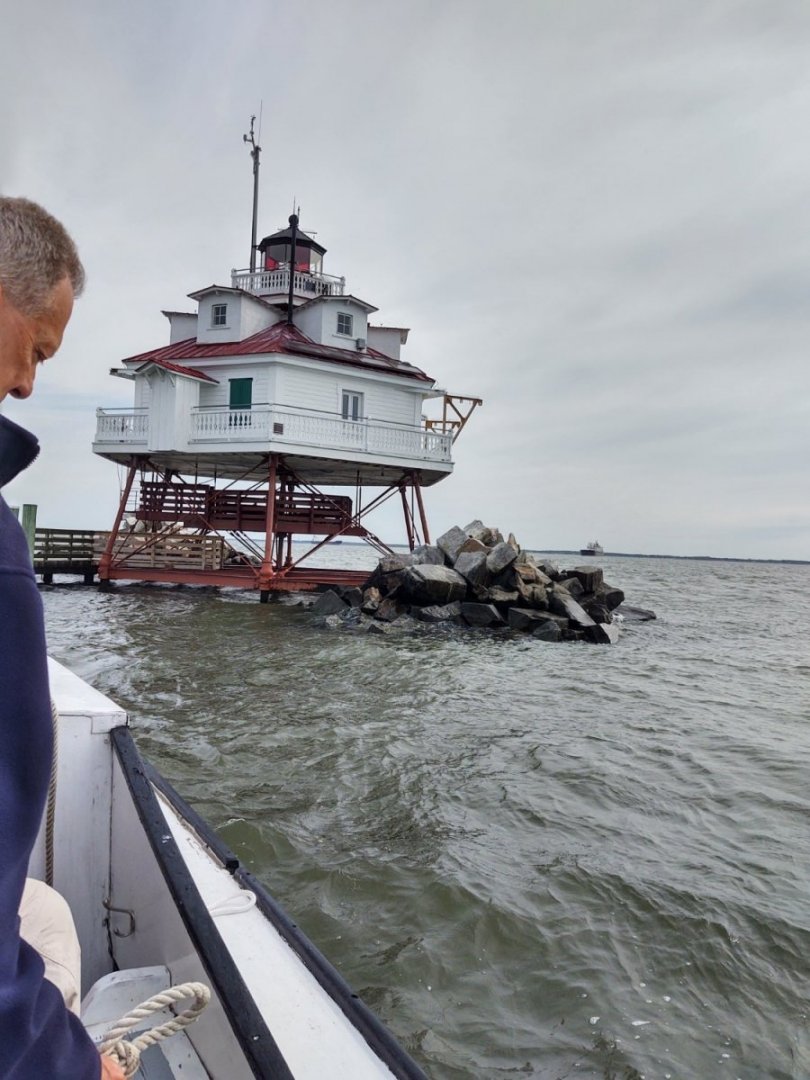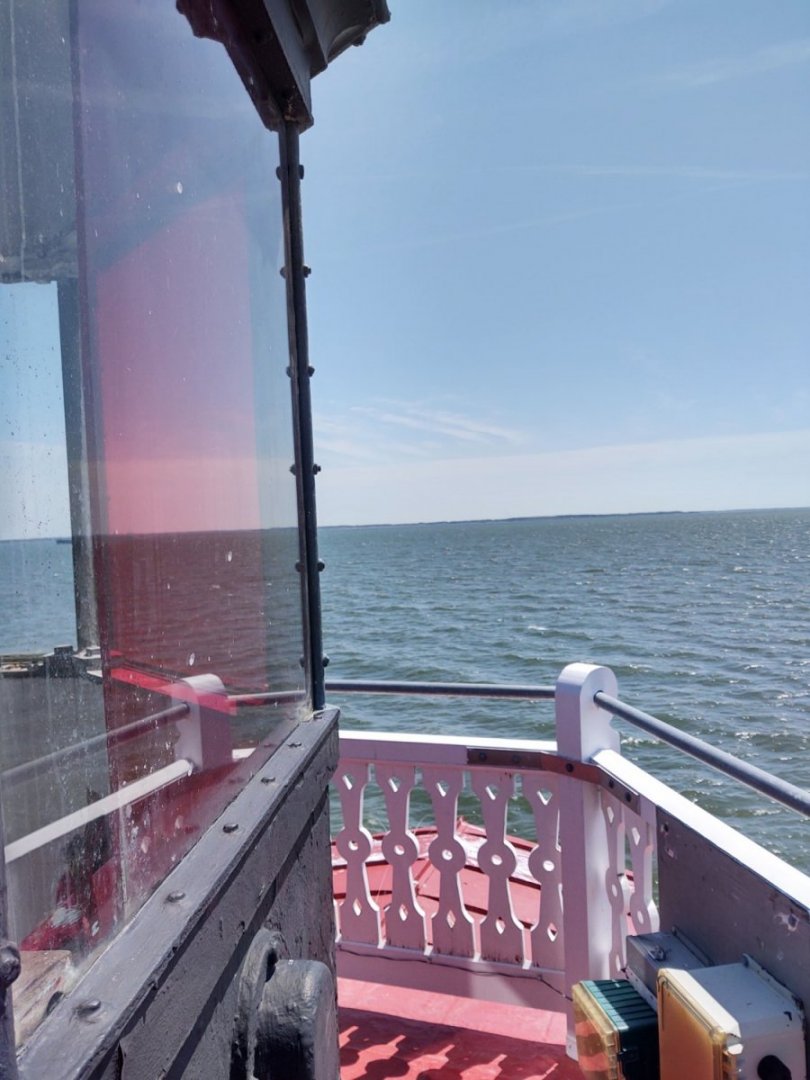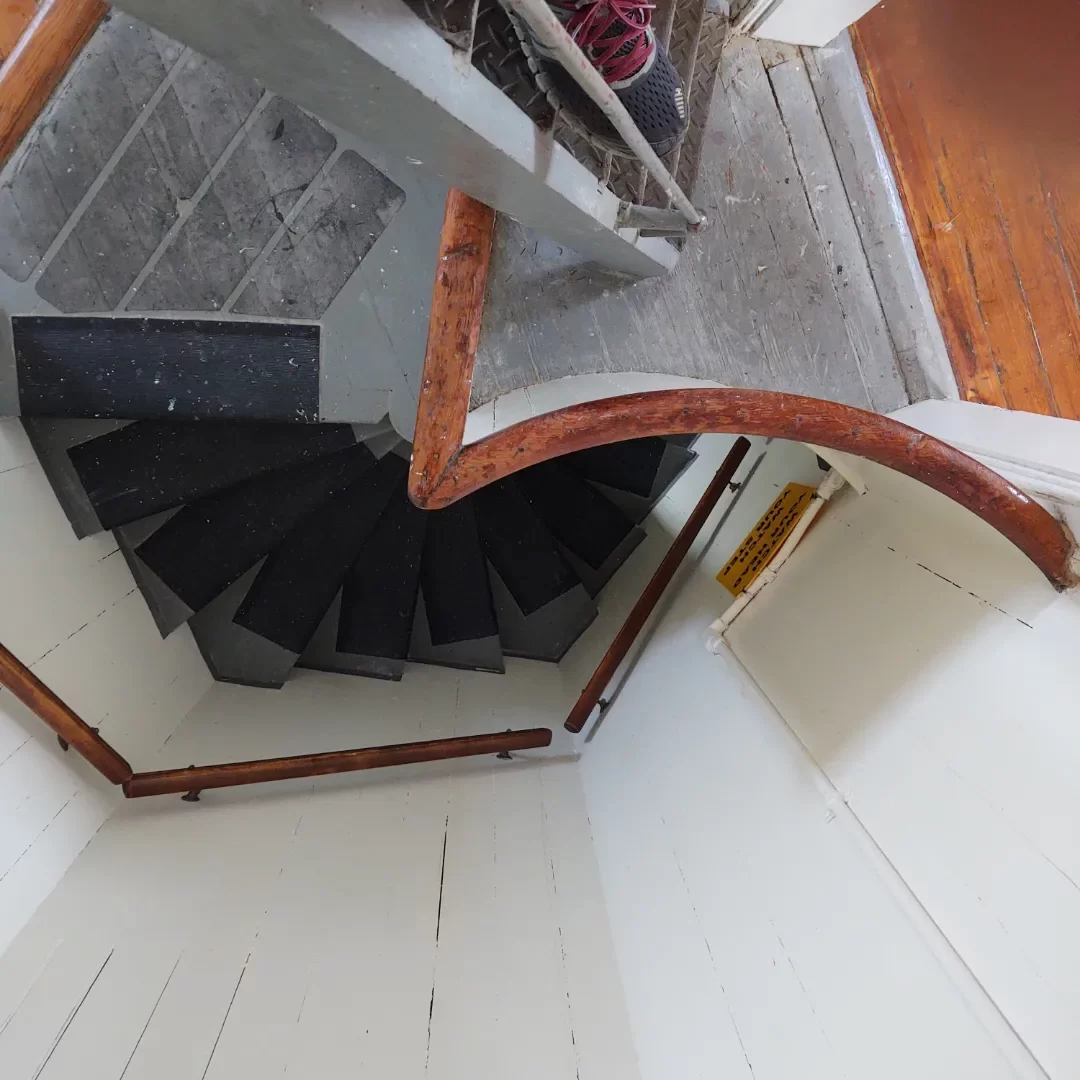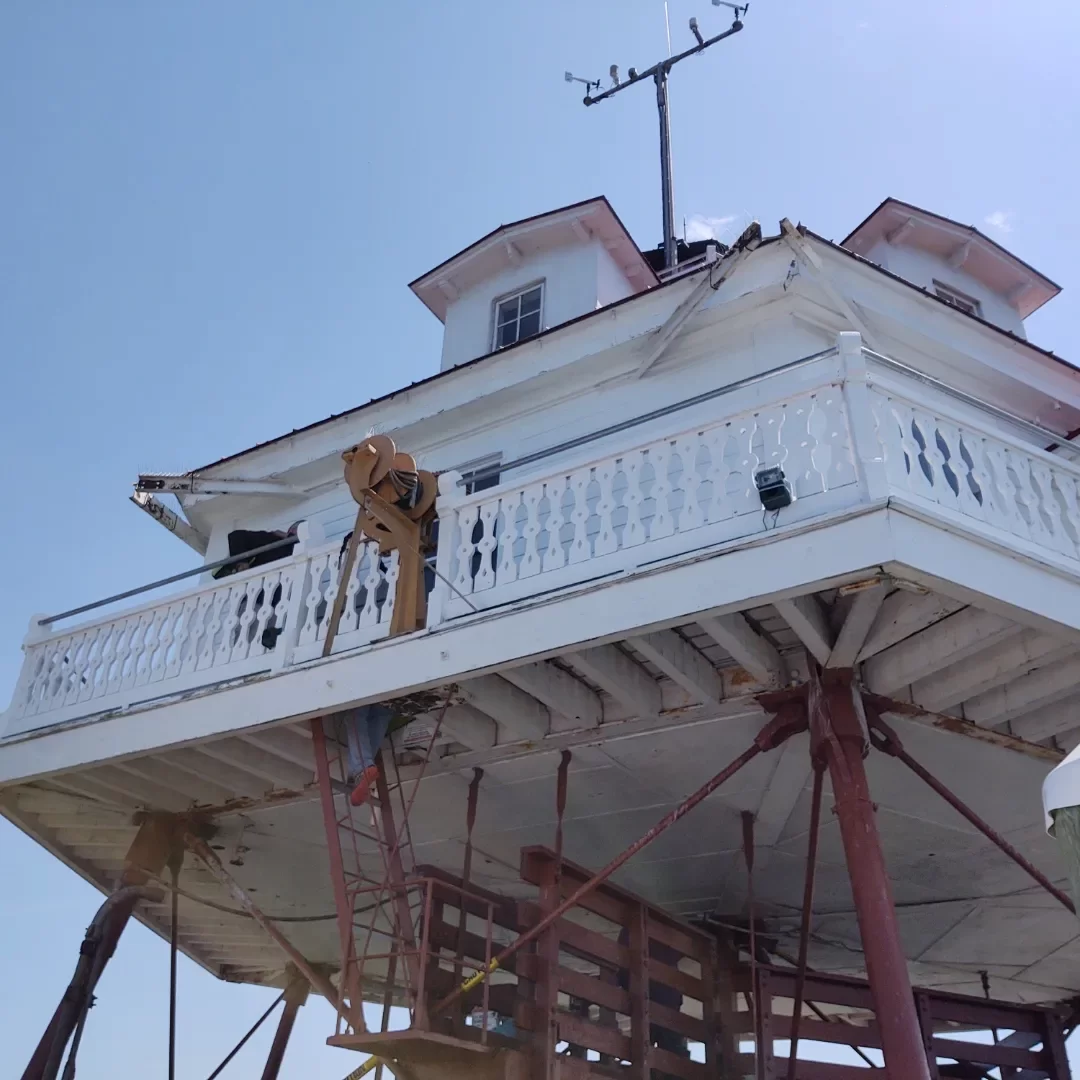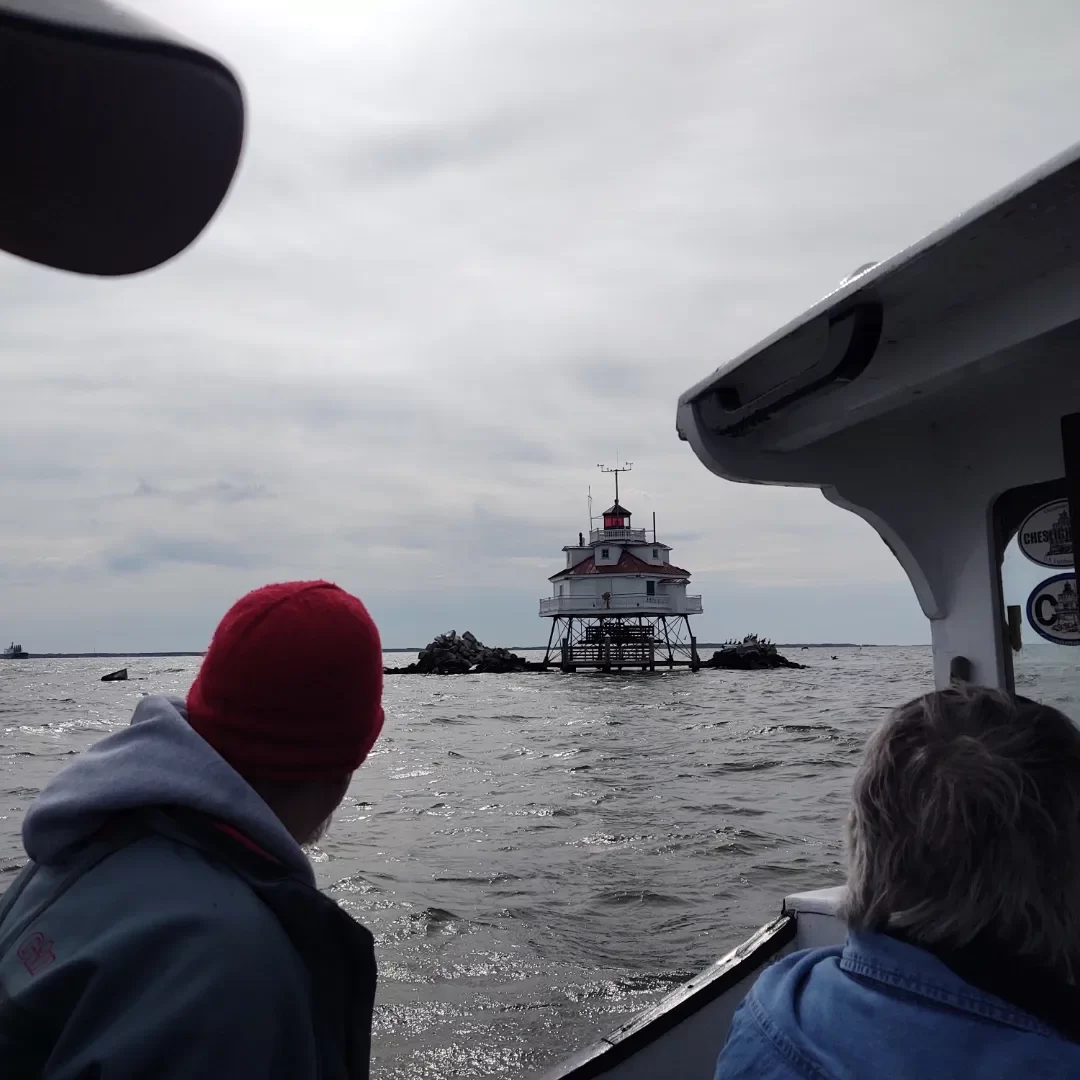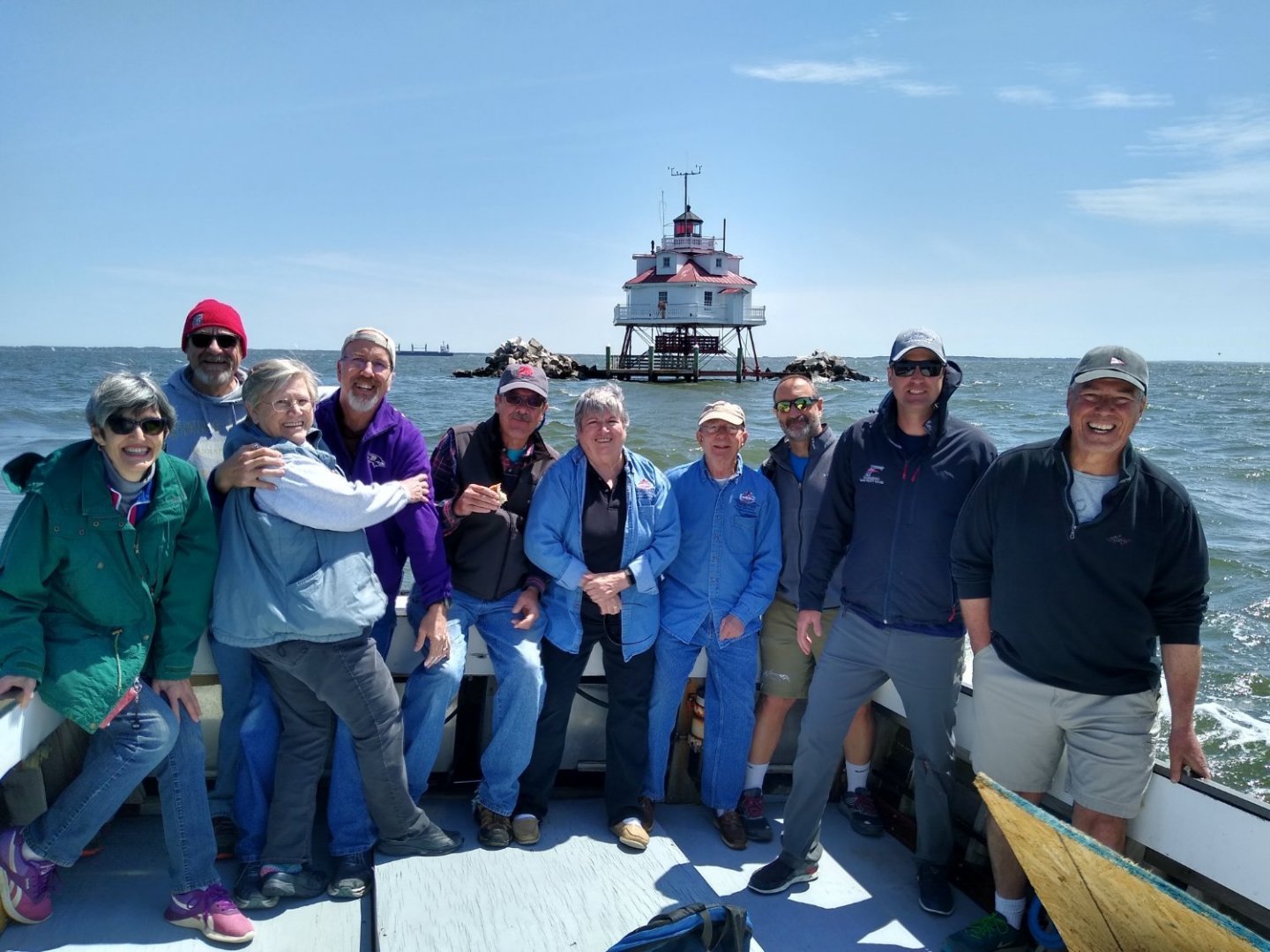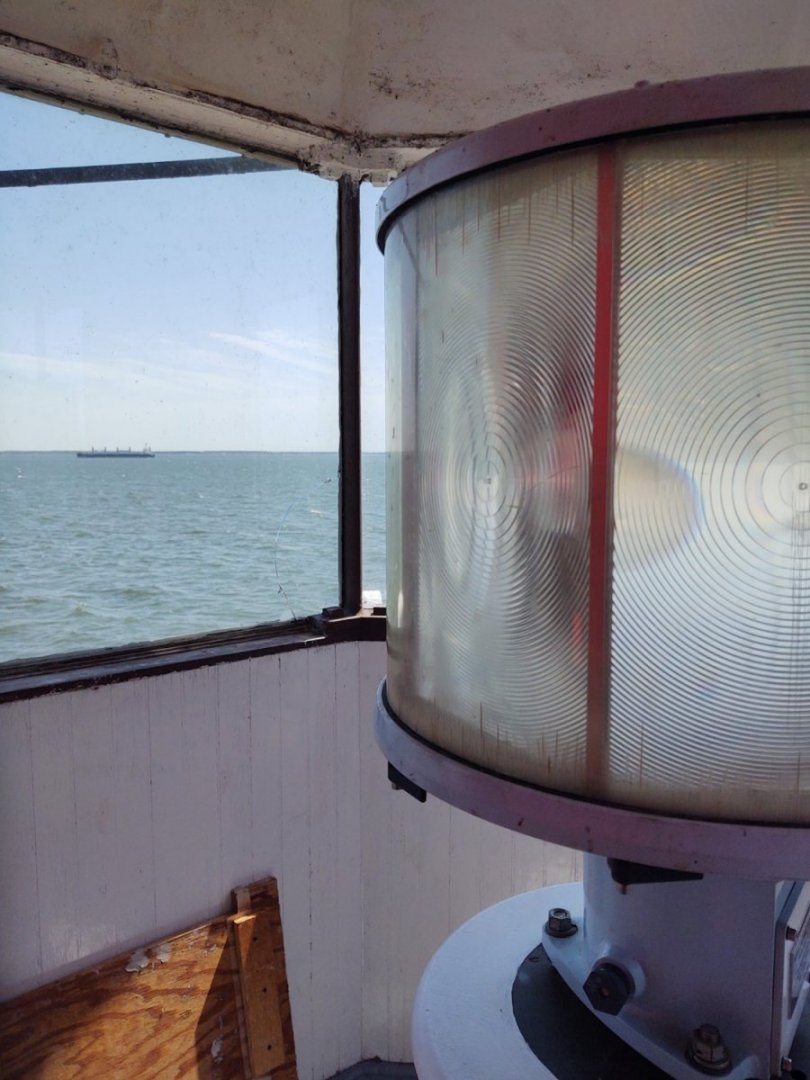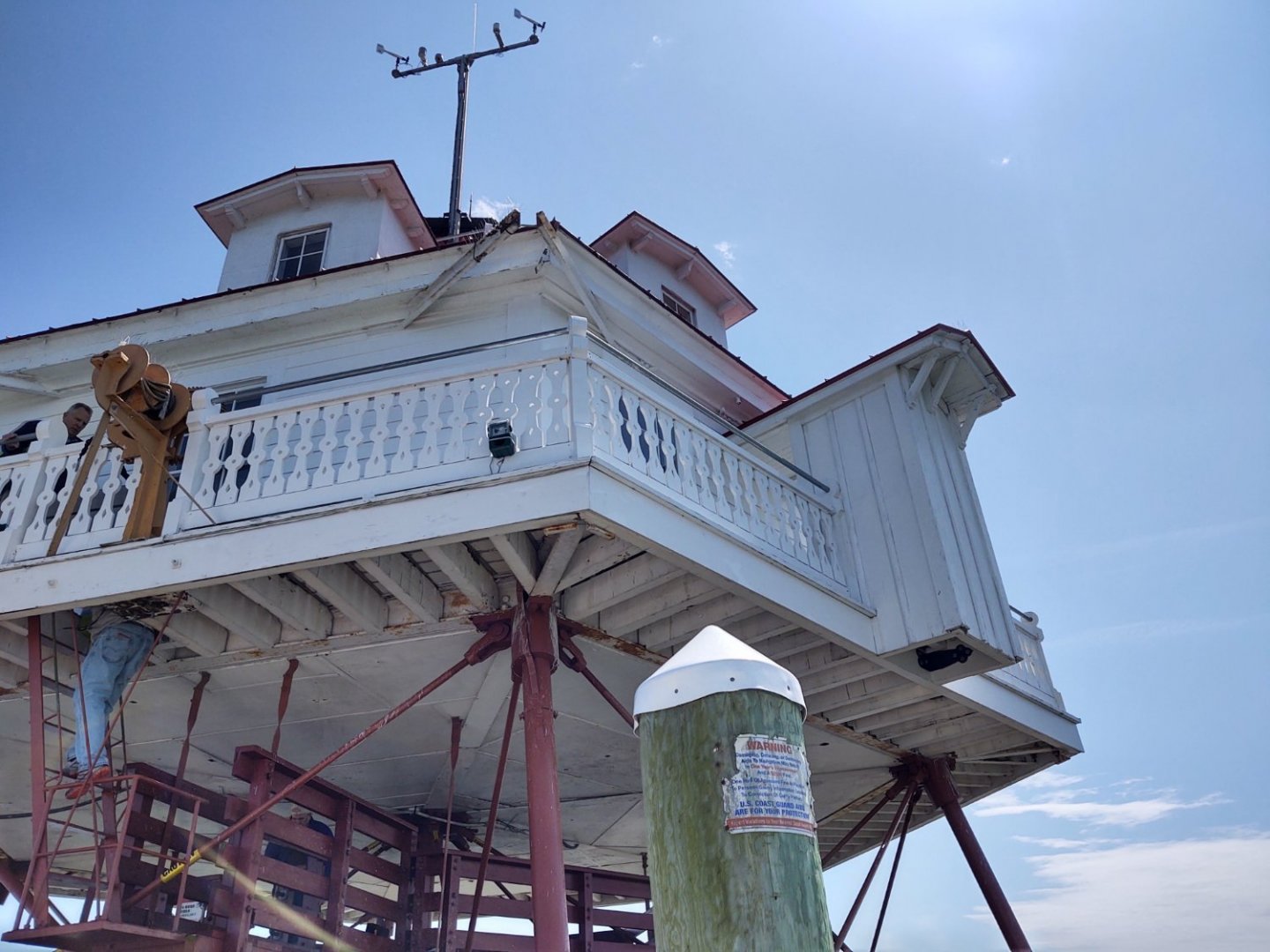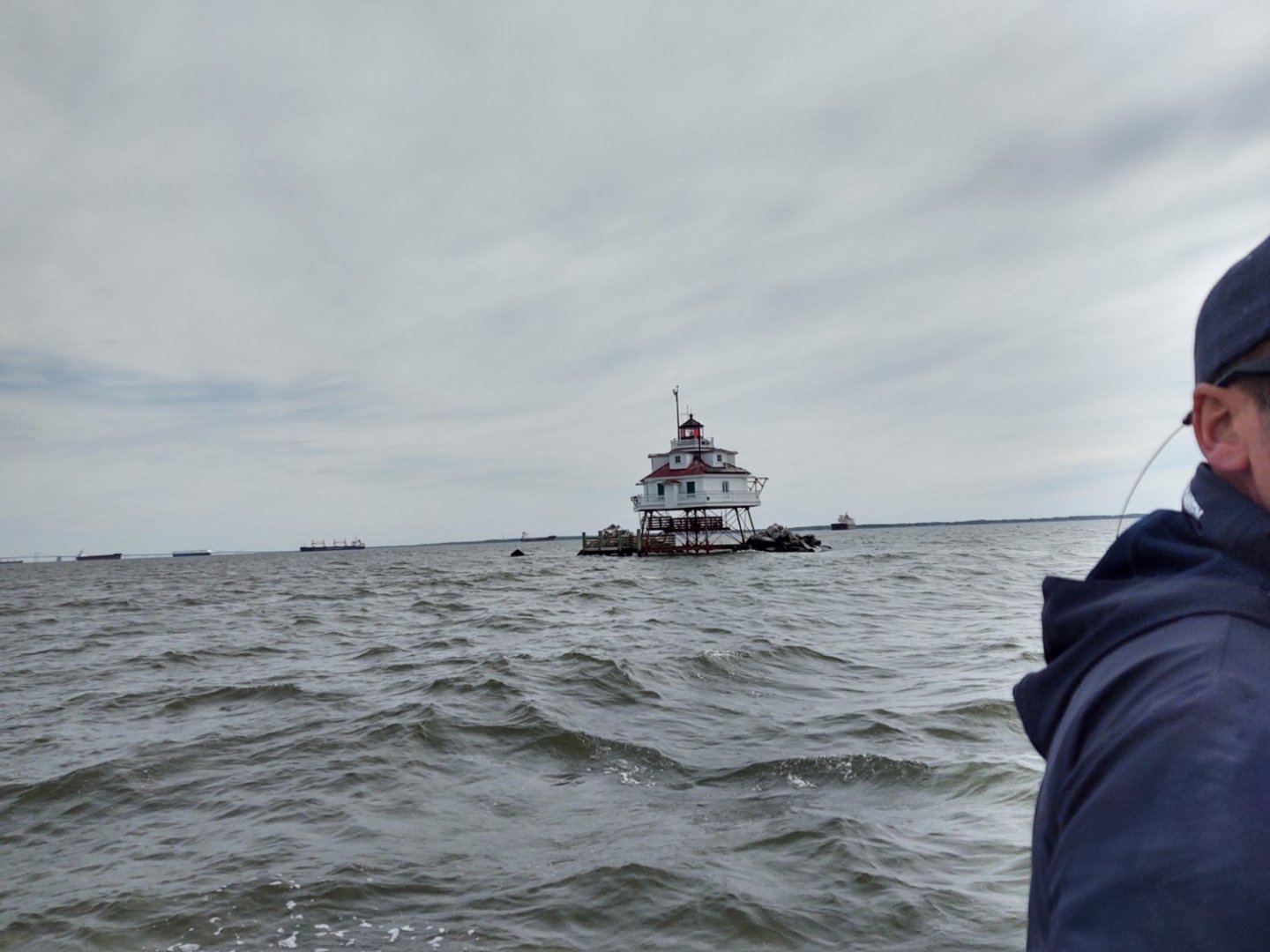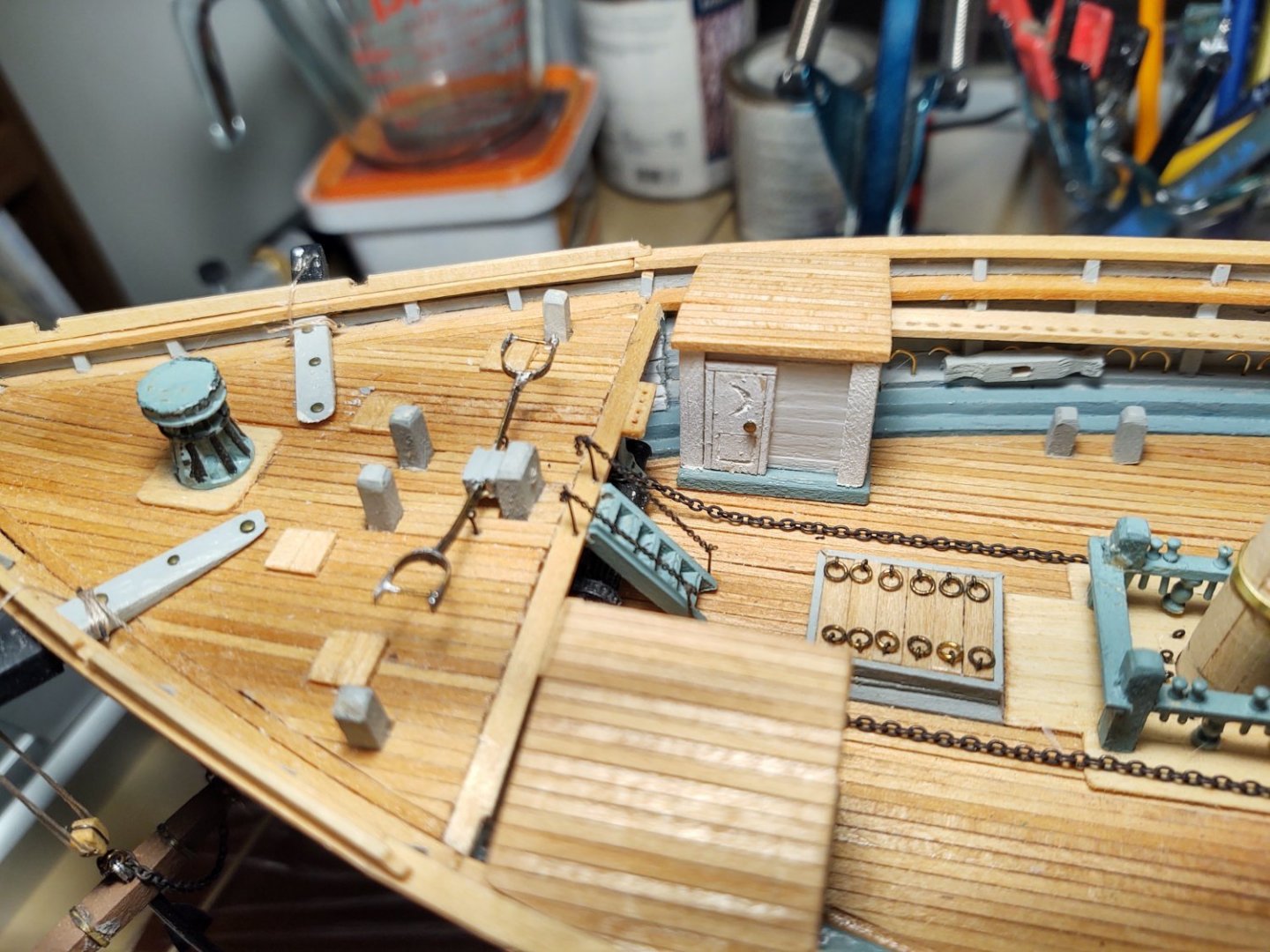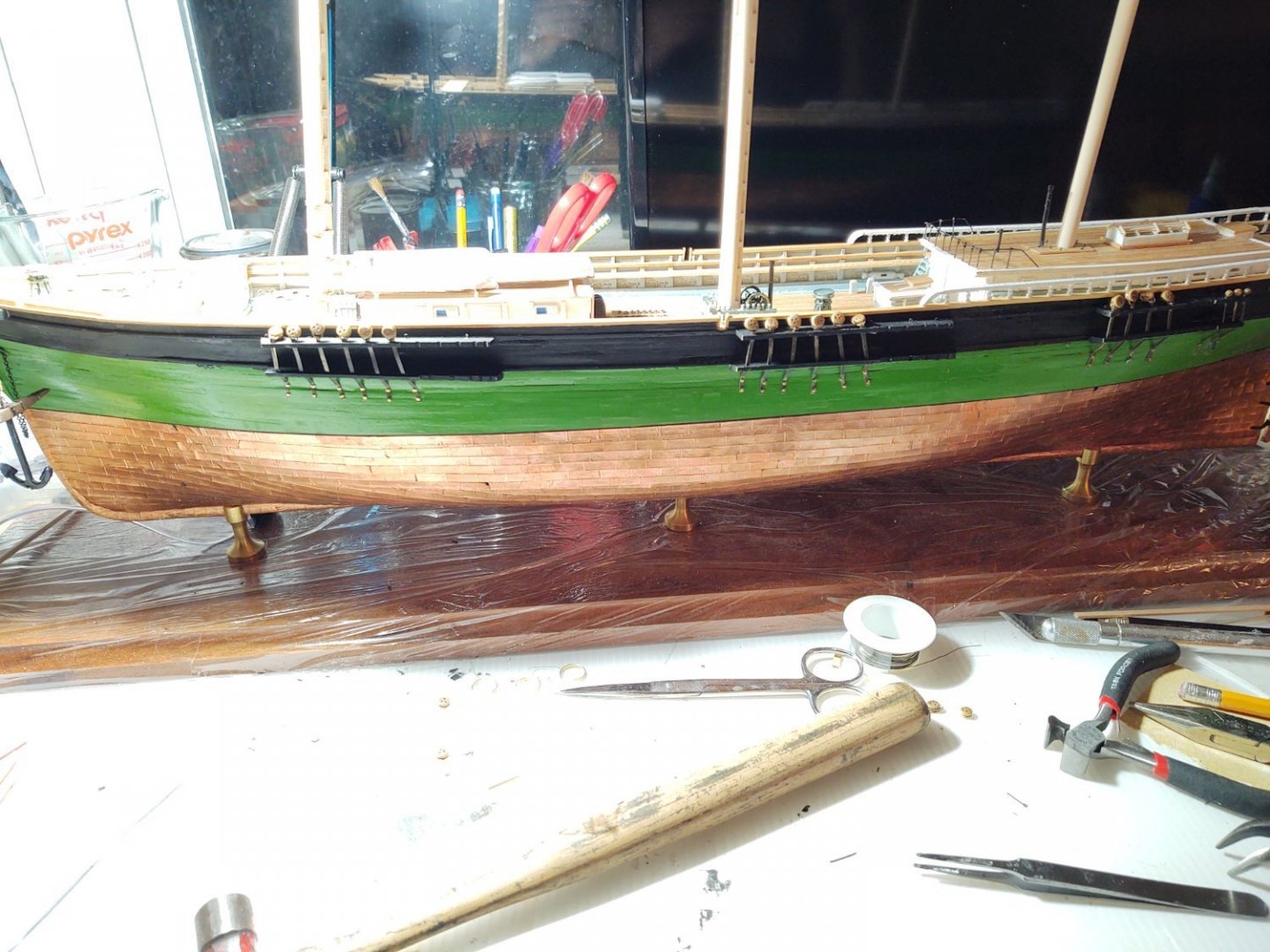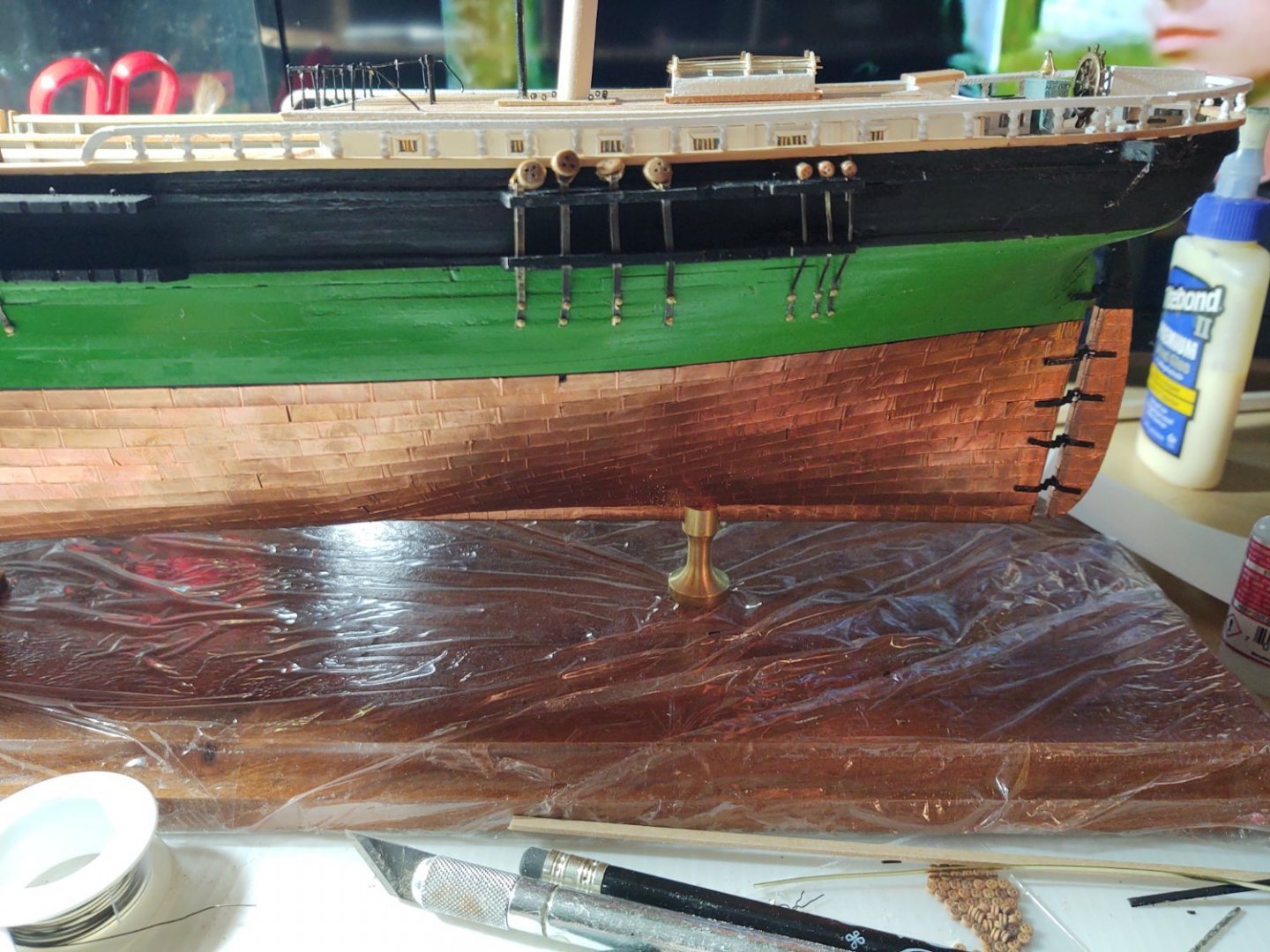-
Posts
720 -
Joined
-
Last visited
Content Type
Profiles
Forums
Gallery
Events
Everything posted by gak1965
-
I think we can agree that McKay was a great naval architect without beating up on the Cutty Sark. The two ships were designed for different purposes (tea trade vs. going around Cape Horn) and Linton designed around composite construction rather than all wood. It would frankly have been interesting to see what McKay would have done with composite construction (and steam) had the yard survived. The Essex that he built in 1874-1876 (although I don't know if he designed it) wasn't stricken from the Navy rolls until 1930(!) George K
- 345 replies
-
- Flying Fish
- Model Shipways
-
(and 1 more)
Tagged with:
-
On the other hand, because the mizzen has a Spencer mast there would be no problems with catching the hoops when raising the spanker.
- 602 replies
-
- Flying Fish
- Model Shipways
-
(and 2 more)
Tagged with:
-
My assumption has always been that you use built masts when getting solid masts of the correct diameter is too expensive. As @ClipperFan points out, the mizzen is narrower than the bowsprit. I'm going to guess and say that McKay could get 2 feet diameter solid masts but 3.5 feet was becoming prohibitively expensive due to more than 2 centuries of logging around Boston. The photo of Glory in Alaska (where finding big trees would be less of an issue) with a fished main, and solid fore and mizzen would seem to bear this idea out. Given that, and the fact that the description of the fore and main (but not the mizzen) mentions fishing, I think I'm going to go with a solid mizzen. The iron hoops are more open to question. In a straight pole, I would think that the hoops would be useful in preventing the mast from failing due to forces acting along the axis of the mast (i.e. downward forces that would tend to split the wood fibers apart) and not forces that are applied parallel to axis of the mast (i.e. forces from the winds on the sails). If there are proper engineers out there, please correct me. Both paintings have value to get the proper look of the ship, but both have issues. Butterworth, for example, removed all of the deadeyes from the shrouds and backstays, the China Trade painting doesn't have the masts that are known to be fished, but has hoops. Actually, calling them issues is a bit harsh, in both cases, I'm guessing they worked.quickly and/or from sketches because they didn't have photos available, and so inaccuracies crept in. But they are both models in a sense, artistic representations of more complex real things. Ideally, an engineer tells me if my supposition about the utility of the hoops is right or wrong. Barring such information, I think I'm going to go with solid mizzen, no hoops given that the photos of Glory's masts don't show them when they are poles and not built. it's fun, kind of like a detective story to go with the construction. Warm regards, George K
- 602 replies
-
- Flying Fish
- Model Shipways
-
(and 2 more)
Tagged with:
-
Thanks for the info. My carriage house also curves toward the stern although I don't think it leaves perfect catwalks. Whether it is too narrow forward or too wide aft, I don't know. I think it's about 5 ft forward and 3.5 to 4 ft aft. The Fish is smaller than Glory and might have been tighter as a result. I'll see how much I can file away on the tops without endangering the fairleads. 1:96 ca be unforgiving at times. George K
- 602 replies
-
- Flying Fish
- Model Shipways
-
(and 2 more)
Tagged with:
-
The description of the Fish's masts (which I know you've seen) says that "Her fore and main masts are fished on every square, and closely hooped, and the fishes extend two feet below the lower deck partners. No ship belonging to this port has such massive lower masts." There is no mention of the mizzen, which I presume is why Ben Lankford ultimately went with a stick mast. The Butterworth painting does show a fished mast, and the China trade painting shows sticks with hoops on all three masts. Would it have been common to put hoops on a stick mast? I don't recall seeing them on the Pacific photos of Glory when it had switched from but to stick masts. It is probably possible to open up the lubber's hole a bit before I seat the mast. The holes were defined by laser cut pieces and are between 1.5 and 2 feet on the short side at scale which are narrow, but I don't have very good reads on the actual size of such a hole. Do you know if the tops in the photo are the original ones or added later?
- 602 replies
-
- Flying Fish
- Model Shipways
-
(and 2 more)
Tagged with:
-
Well, some progress on the lower masts. The fore and main were mostly constructed, but not painted or any additional details added. The mizzen needed the ring of belaying pins, which is the next item I worked on. I marked out the relevant circles on a piece of appropriate thickness wood from the kit, drilled a pilot hole and then used a conical grinding bit in my dremel to make the hole. I then drilled out the holes for the pins, and finished the outside with a sanding bit. It was the only way I thought I could make it without having the whole thing break into a million pieces when I drilled the holes for the belaying pins. As it was, it split in two, but a little glue and we were back in business, as seen below: Next up was to paint the lower masts. I started with some Tamiya flat white from a spray can to get a base on the pieces, followed by brushing on Tamiya flat white to get good coverage. Unfortunately, I ran out of paint, so I've only done the fore and mizzen. The photo below shows the mizzen and the main, and you can see the difference between the spray only and the final look (the unpainted portion of the mizzen will be out of sight). Oh, while i was waiting for paint to dry I mounted the ships boats on the main deck house (the mast is not yet attached, and it's an optical illusion that it is facing forward). I then spent some time on the foretop. After painting, the holes for the futtock shrouds and fairleads had to be reopened. In addition, the plans indicate that the tops had an iron band around the curved edge. I made this with some black, 24 gauge steel wire, bent to shape on the edge of the top, and leaving the holes for the futtock shrouds uncovered (so basically there were 5 pieces of wire, each between one of the 6 holes). The futtock shrouds were made from 1/8 deadeyes (the closest I had to 10" at scale) and black 32 gauge wire, anchored onto the futtock band using a large eyebolt. Here is a picture of the mast from the starboard: And a similar shot showing the mast top from above, with the 'iron band') Finally the same shot of the whole ship, but with the focus on the deck, rather than the mast top. Next up are the rest of the mast tops and futtock shrouds, and the belaying pins. Then the topgallant masts and I can start putting some shrouds in place. As always, thanks for the likes and encouragement. Please have a good Memorial Day weekend, however you choose to mark it. Regards, George K.
- 602 replies
-
- Flying Fish
- Model Shipways
-
(and 2 more)
Tagged with:
-
Discovery has actually changed a lot from its 1904 appearance. The deckhouses have changed, two masts were moved forward various amounts to improve sailing trim, and the rig modified to use split topsails among other things. As to the color of the funnel, I can't really say... Regards, George K
-
Yeah, the plans suggest 2 different sizes of iron plate and I had two sizes of brass, one that was 3" at scale, and the other 6" at scale. Using the 3" was probably too small for the shrouds and 6" too large. I don't have tools to mill the material to a smaller size and couldn't find intermediate sizes online. So, I decided to go slightly too large but retain the different sizes of plate. The deadeyes themselves are also off a bit. There are something like 5 or 6 different sizes mapped to three sizes in the kit, so some of the mizzen deadeyes are too large and some of the ones on the tops are going to be too small. One of the reasons I'm thinking about doing Discovery at 1:64 is so I don't have to deal with some of those choices, the 1/32"/0.5 mm spacing in commercial wood, brass, deadeyes, etc. is 2" then. Easier to get things properly in scale. Regards, George K
- 602 replies
-
- Flying Fish
- Model Shipways
-
(and 2 more)
Tagged with:
-
Well, I've reached a couple of milestones, although for whatever reason it was a much longer slog than was consistent with the actual technical/physical complexity of the task. So, the first milestone is that the chainplates are finally complete. As I mentioned before, the cuts in the channels for the plates were aligned to the plans so that the plates themselves should align with the path of the shroud or backstay. Because that means that getting the 'bolts' to align properly will require that each plate have a custom length, I put tape where I wanted the upper bolt to land, and drew a line on the tape where the lower bolt should sit. I then fitted the stropped deadeye with the plate, bent the brass as needed and marked the 'bolt' locations with a pin vise, drilled out the holes with a (power) hand drill, and opened it up further with a pin vise. This opened the hole wide enough without mangling it. You can see the 31 chain plates (11 fore, 11 main, 9 mizzen) in the photo below, with three sizes of deadeye and three different chainplate materials. (Also the tape, which had to come off before I mounted them onto the hull). After that, I glued each plate in place in the channels, and on the hull, covered the edge of the channels with a pre-painted black wood strip, and drilled the holes in the hull where the nail that represents the bolt would sit. The nails were then glued into plates. As mentioned before, the upper backstays are quite narrow, so rather than drill holes, I glued the plate to the hull, glued a short segment of similar diameter blackened brass below it, in line with the path of the plate to represent the preventer, leaving an approximately 1 mm gap with the chain plate. I then drilled holes above and below the "preventer" and glued the nails in. Here are some photos: There are imperfections, but working ships had imperfections. That's my story, and I'm sticking with it. I also installed the irons on the jibboom and mounted it on the ship. It has the necessary holes drilled for the various lines that will eventually grace it, and the eyebolts that are representing the endpoints of much of the standing rigging on the bowsprit and jibboom. Finally, the extra brass arrived from Model Shipways, and I've put the bands on the lower fore and main masts. They need only the bolsters on the tops and I can paint them white, and start thinking about installation. Here are three (not particularly good) views of the ship to date. The first from above showing the lower masts, the second showing the whole ship up to the bowsprit, and the third, a (poorly lit) view of the whole ship. So, I still have some work on the main deck (tie down the ship's boats, build 4 ladders, attach the forward bell, blacken and install the belaying pins in the pin rail, but we are pretty much starting the transition to rigging, which is pretty cool. One question for the cognoscenti. According to the plans, it appears that many of the connections between the bowsprit and the hull are mediated by hearts, rather than bullseyes or deadeyes. Shrouds and backstays seem universally to use deadeyes. On the Niagara the bowsprit standing rigging was a mix of deadeyes, bullseyes, and hearts. I assume that there was a reason for these choice, curious if anyone knows why. As always, thanks for looking in and for the likes! Regards, George K
- 602 replies
-
- Flying Fish
- Model Shipways
-
(and 2 more)
Tagged with:
-
That photo doesn't look like it was taken while they had any kind of sails set. I see that it is lightly attached to the rails, but you might just as easily suggest it is a mooring line (I think I see it going into a chock in the upper part of the photo) being kept off the deck, perhaps to prevent it from sitting in water and rotting?
- 481 replies
-
- Cutty Sark
- Revell
-
(and 2 more)
Tagged with:
-
That's a great looking Connie! No reason to stop, everyone breaks things and had to repair. Once the basic hull is done, assume you are going to break something at least once every three sessions until the standing rigging is in place (it helps stabilize all those spars in the model as in life), at which point it'll drip to maybe 1 in 4 or 5 sessions. That's why we put them in cases (well and the dust). I more or less mashed all of the rigging on the bowsprit and broke off the jibboom of my Niagara at one point (a story or almost mind boggling stupidity on my part). It was fixed and moved on. Both ships are looking great! George K
- 481 replies
-
- Cutty Sark
- Revell
-
(and 2 more)
Tagged with:
-
This intrigues me. Do you mean the estimate of how much the spar projected from the deck was 4 feet shorter than you thought (caused by thinking that a spar of length n was stepped further vertically in the hull)? Or something else?
- 602 replies
-
- Flying Fish
- Model Shipways
-
(and 2 more)
Tagged with:
-
Yes, Lars' site is a great resource. The numbers from there and the plans definitely match up, although you need to know (as I do now) the the dimension being listed for the ropes are circumference not diameter. I assume you mean iron for the futtock shrouds? That is consistent with the plans and I approve since it's way easier to make them out of wire 🙂 than string. Regards, George K
- 602 replies
-
- Flying Fish
- Model Shipways
-
(and 2 more)
Tagged with:
-
That makes sense. 10.5 inches in circumference is a 3.4 inch diameter which is 0.035 inch at scale, against a .028 largest diameter thread provided with the kit. I knew something was off in my read of the plans. Thanks! George K
- 602 replies
-
- Flying Fish
- Model Shipways
-
(and 2 more)
Tagged with:
-
Hi all. I was hoping to reach out to the collective wisdom of the FIsh and McKay clipper ship builders out there. Having finished fabrication of the starboard side chain plates for the fore mast has me thinking that I will soon be able to start running shrouds, and I find I often need to spend a few days staring at plans to understand everything that needs doing properly. Usually the shrouds are pretty straightforward, but this time the plans do not make much sense to me, so hence my questions to you all. Take a look at the segment of the plans below showing the lower shrouds for the main and mizzen masts: Most of it makes sense. For example, looking at the main, we have 5 different size deadeyes (16", 12", 9", 6", and 5.25") that are reduced to the three supplied deadeye sizes supplied with the kit (3/16 for the 16", 1/8" for the 12, and 3/32 for the rest). Fine. But the rest of the numbers make no sense to me at all. 10.5" shrouds on the main with 1.5" ratlines (right side of the image just over the shroud lanyards)? 8.25" shrouds with 1.5" ratlines on the mizzen (right side of the shrouds, halfway up)? That can't be right, those are the sizes of mooring lines on aircraft carriers, not shrouds on a clipper. The lines arranged side to side would cover more than 1/2" on the model at the top. And at scale a 10.5" line would be 4 times the diameter of the largest line that comes with the kit. I must be missing something here. Open to any suggestions as to where I have gone astray, or thoughts around 'typical' shroud sizes on McKay clippers. Thanks in advance, George K
- 602 replies
-
- Flying Fish
- Model Shipways
-
(and 2 more)
Tagged with:
-
A short update on the progress of the Fish. For some reason, the chain plates and deadeyes were turning into a bit of a blocker for me. However, I received the material for making the plates for the lower backstays from BlueJacket and so no excuse. I have finished channels and plates on the port (or as I called it earlier the non-display or "practice") side of the ship - 16 for the shrouds, 6 for lower backstays and 9 for the upper backstays. The starboard side should now follow pretty shortly. The photos below show them reasonably well. I started with the main, moved to the mizzen and then finished with the fore, and you can see that the practice helped. The mounts on the hull are a lot straighter by the time I got to the fore, so hopefully that will continue on the 'display side. While that has been going on I've been continuing to work on the masts. As you can see in the image below I've added the cheeks to both the fore and main, and have begun putting on the mast bands prior to painting. I had thought about having the mast bands be black iron, but the available evidence (the Butterworth and Chinese painting) all suggest that the bands were painted with the lower masts, so white they will be. The main isn't fully banded yet because I ran out of brass of the right size - however, I got an email about an hour ago from Model Shipways indicating that they are shipping me some additional brass in response to my request, so that should be resolved pretty soon. I had earlier asked about people's experiences with their part replacement policy and it appears that I am another satisfied customer. Finally - as hinted in the above, I've been building the mast tops. The photo below shows the fore and main, more or less ready to mount on the cheeks. The mizzen just has the two laser cut pieces, I'll get it soon enough. The holes for the fairleads and the futtock shrouds are already in place. The real ship has an iron band on the outer edge of the upper side of the top, which I will add once it is painted. I'm debating using pre-bent 1/32 square stock or some 24 gauge black steel wire. The steel wire is about 1.5" at scale, the wood stock is 3" at scale. I'll probably try both and glue the one that looks best. You can also see that I am working on the jibboom. It's drilled, it just needs another "iron" band and 3 eyebolts and it will be ready to mount. So, the plan moving forward has three things going on at once - doing the chain plates on the starboard side, finishing the lower masts and tops, and starting to rig the bowsprit. I've chosen to conclude that this allows me to make progress in several areas while things are drying rather than suggesting that I have a disorganized mind and un-diagnosed ADHD. That is my story and I am sticking with it, plus I find that adding line tends to get me motivated to do more. Actually make that 4 - there are a few things left to do on the hull (a couple of ladders, lashing down the 3 ships boats, maybe emplacing the myriad belaying pins). Anyway - thanks for looking in and for the encouragement and likes. Regards, George K
- 602 replies
-
- Flying Fish
- Model Shipways
-
(and 2 more)
Tagged with:
-
Some more photos. Not that this will surprise anyone, but the protuberance on the left is a privy. All water comes from cisterns fed from the roof which I can tell you is not free of gull excreta. it's possible that it used to be less of an issue, but they lived rough back in the day.
- 602 replies
-
- Flying Fish
- Model Shipways
-
(and 2 more)
Tagged with:
-
Uh oh, I think we are heading into Ship of Theseus territory here, and that is not the ship I'm modeling 😀. Short answer is I don't know. Longer answer is that the light was renovated and repaired/updated over the 111 years it was occupied. So, for example, the Fresnel lens is obviously no longer in place, and it is lighted and rotated by a set of large batteries, the weight system that used to run it are gone, the furniture is period correct if not original, etc. And, well, it's a wooden structure in the middle of the bay. In fact, we were there that day to remove and replace the shutters, scrape the paint under the shutters and paint the underlying wood so it wouldn't get damaged while the new shutters were being cut to size (they are apparently all slightly different). We identified at least 3 or 4 pieces that would have to be replaced due to water damage when the shutters came off, so you get the picture. So the medium answer is probably the screw piles, some of the structural elements, and a decent amount of the interior (you can see where someone plugged the hole in the floors where the weights used to descend, for example), but I doubt much of the external cladding is original.
- 602 replies
-
- Flying Fish
- Model Shipways
-
(and 2 more)
Tagged with:
-
Another update coming soon. In the interim, a question and a palate cleanser. The question - has anyone used Model Expo's replacement parts line before? I seem to be short on some of the brass - don't know whether I've just used it wrong or if there wasn't enough. I sent an inquiry via the 'missing parts' page. Recognizing that I'm not sure why I'm short, I let them know that I'd pay for the brass, but the strip is not available as a separate, purchasable item from their catalog. I haven't heard anything since - do they usually respond, just send the parts, ignore everything? I've vaguely heard good things about this, so the radio silence is a surprise. The palate cleanser. Over the weekend I was fortunate enough to spend a day doing restoration/maintenance on the Thomas Point Shoal lighthouse in the Chesapeake Bay off of Annapolis, MD. Built in 1875, accessible only by boat, it was the last manned lighthouse on the bay, not being automated until 1986 (!). Just a couple of snaps of the lighthouse and the gray haired rogues gallery that went out to work on it. The boat is a wooden Chesapeake Deadrise that started life as a crabber. Hope everyone had a great weekend, George K
- 602 replies
-
- Flying Fish
- Model Shipways
-
(and 2 more)
Tagged with:
-
The markings will disappear a bit as the copper tarnishes and they give the plates a bit of surface interest, suggesting the nails that are there without putting in a bunch of giant out of scale dots. That's my story and I'm sticking with it. Bottom line is that it looks great, keep on rolling. George K
- 57 replies
-
- Flying Fish
- Model Shipways
-
(and 1 more)
Tagged with:
-
We had a once around on this topic earlier. Royal and US Navy ships holystoned into the 20th century in ships that had wooden decks, but given the small crews compared to similarly sized warships it seems less likely that the decks of commercial vessels were regularly holystoned. Even in British naval service by the mid-19th century it was being done less frequently (2-4 times/month) and the US Navy banned it on the battleships b/c it was wearing the teak decks down at an alarming rate.
- 481 replies
-
- Cutty Sark
- Revell
-
(and 2 more)
Tagged with:
-
I had the same problem in the beginning with the MSW kit. The problem (I think) was that I misread the MSW plans. I concluded that the core of the main and fore masts were 24 inches (1/4" at scale), which was also the size of the square top of the lower masts. However, more careful reading of the plans suggested that the square top of the main (at 1:96) should have been 1/4", the square top of the fore 3/16", and the core on both the masts should be 3/16". Once I built the masts up on a 3/16 core, the tapering didn't remove the chapeling and the masts looked right. I had to then build up the square top on the main by sheathing it with some 1/32" wood, but it was a minor issue relatively speaking to resolve. This may not be what is happening in your case but it's something to maybe think about. Looking awesome, BTW. I loved how you put the bars on the carriage house windows. I put some on my Fish, but they were nowhere near as clean as the ones you made. Regards, George K.
-
It's been about 3 weeks since I've done an update. A combination of things has slowed everything down, ranging from some extra efforts needed with work to training for the Cherry Blossom 10 mile race that was last weekend. As I age, the miles take longer and cost more. Plus, for some reason making the chain plates has been something of a blocker for me. As I mentioned in previous posts, there are three sizes of deadeyes attached to the chain plates for all three masts. The largest deadeyes use 1/16" wide brass strip which is wide enough to drill for the nails that are representing the bolts. They are 6 inches at scale and that seems about right for the size of the deadeyes. I'm using 1/32" wide brass (so 3" at scale) for the smallest of the deadeyes (these are for the backstays in the upper works). They seem right but I don't have either a drill press or other obvious means of cutting holes in the strip to push the nails through. I've worked out a method for dealing with those (more anon). There seemed to be no intermediate size of brass strip available for the lower backstays. However, @MrBlueJacket from sent me a small test strip of 1/16 by 1/64 Britannia strip. Even though it's the same width as the brass, it just looks different and somehow right for the intermediate size chain plates. Once my order arrives I'll start on those. The pic above shows the chainplates on the port mizzen. The four large ones are in place, and the three smallest. What I wound up doing was stropping the deadeyes with some 34 gauge steel wire and then bending the 1/32 brass strip through the strop, covering the area where I wound the strop with the bend of the brass (if that makes sense). Then I put bent the brass, installed it in the channels, and cut it off where I wanted the top "bolt" (i.e. the nail) to sit. I used a bit of CA glue to attach the bottom of the plate to the hull. I then took a 5 mm strip of blackened 1/32" brass that represented the preventer and glued it to the hull about 1 mm from the bottom of the plate, and in line with the direction that the plate was facing. I could then drill two small holes, one between the plate and one below the "preventer", and glue nails into the holes. It's not perfect, but I think it works. Where I am now with the plates is that I've done all of the shroud plates on the port side of the ship and the first three of the upper backstays. There are 6 lower backstay plates and another 6 of the upper backstay plates, but having worked out how to make them all, I feel more confident about moving forward. I expect to display the starboard side, so this was the "practice" side, and I've learned some good lessons for when I move to the other side of the ship. Below is a (terrible) photo of where she stands now. I couldn't get the light right, the point is that the chainplates are coming along, if slowly. I've been doing some other steps as well. I've been adding the mast hoops to the fore mast, and will move to the main once that is done. I've also started fabricating the mast tops, that will be coming soon. I added the ladder from the main to forecastle, which I am oddly, and perhaps strangely proud. The ladder is a bit chunky (that's what happens when you don't use the fittings, I suppose), but what I'm proud of you can see in the photo below. I made the railing out of chain and 4 jackstay eyebolts. I don't know if the real ship had chain railings, but somehow I thought that they might, so I took some of the rigging chain and attached it to blackened eyebolts. As an aside, you can see the lowest of the mast hoops in the photo as well (all the paintings show the masts as painted white (including the hoops) so they are going on prior to painting. As always, thanks for looking in! Regards, George K
- 602 replies
-
- Flying Fish
- Model Shipways
-
(and 2 more)
Tagged with:
About us
Modelshipworld - Advancing Ship Modeling through Research
SSL Secured
Your security is important for us so this Website is SSL-Secured
NRG Mailing Address
Nautical Research Guild
237 South Lincoln Street
Westmont IL, 60559-1917
Model Ship World ® and the MSW logo are Registered Trademarks, and belong to the Nautical Research Guild (United States Patent and Trademark Office: No. 6,929,264 & No. 6,929,274, registered Dec. 20, 2022)
Helpful Links
About the NRG
If you enjoy building ship models that are historically accurate as well as beautiful, then The Nautical Research Guild (NRG) is just right for you.
The Guild is a non-profit educational organization whose mission is to “Advance Ship Modeling Through Research”. We provide support to our members in their efforts to raise the quality of their model ships.
The Nautical Research Guild has published our world-renowned quarterly magazine, The Nautical Research Journal, since 1955. The pages of the Journal are full of articles by accomplished ship modelers who show you how they create those exquisite details on their models, and by maritime historians who show you the correct details to build. The Journal is available in both print and digital editions. Go to the NRG web site (www.thenrg.org) to download a complimentary digital copy of the Journal. The NRG also publishes plan sets, books and compilations of back issues of the Journal and the former Ships in Scale and Model Ship Builder magazines.


